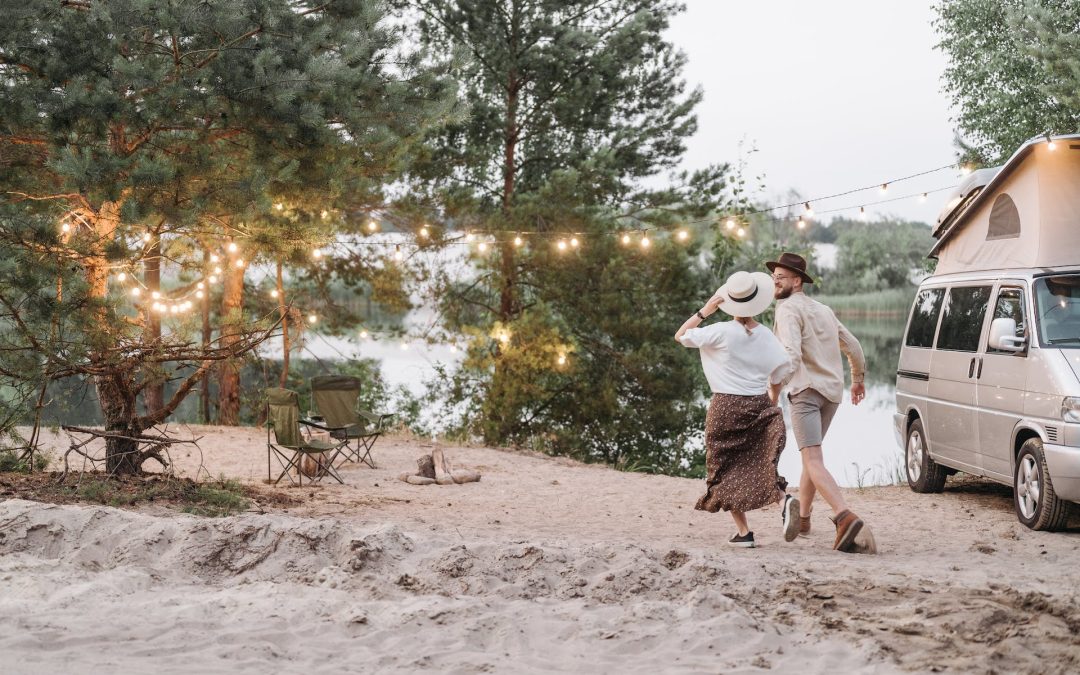
by Chuck Price | Jan 16, 2024 | Class B RV
Why Choose a Class B RV?
Imagine waking up to breathtaking mountain vistas, waves at your doorstep, or the vibrant hum of a city square – all from the cozy comfort of your Class B RV. Perfect for solo travelers, couples, or small families, these compact campers offer the freedom of a studio apartment on wheels.
Key Features at a Glance:
| Feature |
Class B RVs |
Larger Motorhomes |
| Average Length |
18 to 24 feet |
25 to 45 feet |
| Fuel Efficiency |
High 20s to low 30s MPG |
Usually under 20 MPG |
| Turning Radius |
Similar to large vans |
Requires wider turns |
| Ease of Parking |
Comparable to a van |
Requires larger spaces |
| Maneuverability |
High (easy in cities) |
Lower (challenging) |
Note: The specific values can vary based on the make and model of the RV.
This visual comparison highlights the practical advantages of Class B RVs, making them ideal for travelers who crave:
- Spontaneous Exploration: Their compact size and maneuverability allow you to easily navigate cities, narrow roads, and hidden spots.
- Off-Grid Adventures: Fuel efficiency and ease of parking extend your range and open up more remote destinations.
- Unlimited Flexibility: Effortlessly change course and discover new places without the constraints of larger vehicles.
If you’re ready to embrace a lifestyle of limitless possibilities and untethered exploration, Class B RVs offer the perfect blend of freedom, convenience, and adventure.
Why Class B RVs Rule the Road
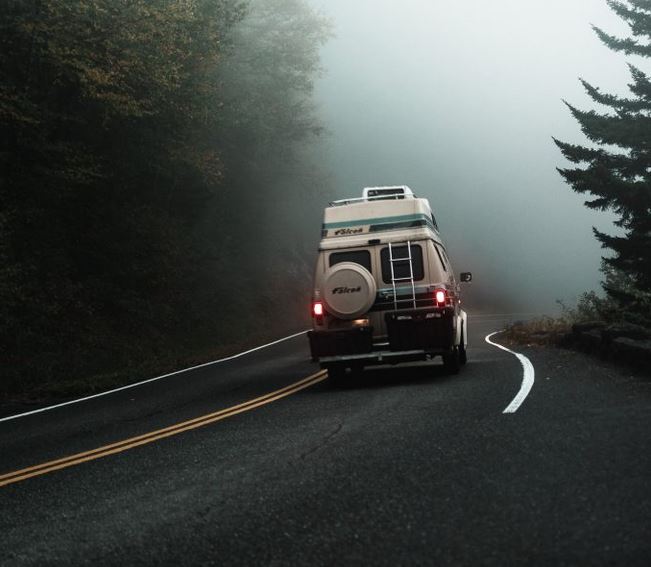
While their size might be compact, the appeal of Class B RVs is anything but. These nimble travelers offer an unmatched blend of freedom, efficiency, and adventure, leaving their bulkier brethren in the dust.
Maneuverability Magic
Imagine squeezing into a bustling city parking spot or navigating a serpentine mountain road with the ease of your own car. That’s the magic of Class B RVs. Their van-like size makes them masters of maneuverability, opening up a world of spontaneous detours and hidden gems waiting to be discovered.
Spontaneity Unbound
No more rigid itineraries or campsite reservations! With a Class B RV, the world becomes your playground. Pull over for a sunset picnic at a secluded vista, explore a charming village on a whim, or chase the perfect wave – all without the restrictions of bigger RVs. Imagine stopping on a dime to sample that local bakery’s renowned cinnamon rolls, or witnessing a breathtaking mountain sunrise without planning weeks in advance.
Fuel Efficiency Freedom
Forget guzzling gas like a thirsty dinosaur. Class B RVs boast impressive mileage, putting even fuel-efficient sedans to shame. This translates to deeper explorations into remote areas, longer journeys on tight budgets, and leaving a lighter footprint on your adventures. Imagine trekking through rugged landscapes or chasing autumn foliage across the country, all while saving up those precious vacation dollars.
Low-Maintenance Living
Gone are the days of wrestling with complex RV systems or fearing costly repairs. Class B RVs prioritize simplicity, streamlining features and making upkeep a breeze. Think quick oil changes, easily accessible components, and less time tinkering, more time exploring. Your B becomes your loyal travel companion, not a high-maintenance project.
But this is just a glimpse into the world of Class B RV living. In the next sections, we’ll delve deeper into real-life testimonials, practical living tips, and explore the diverse range of models available to match your unique travel style. So buckle up, adventure seekers, and get ready to discover why Class B RVs are truly the kings of the road!
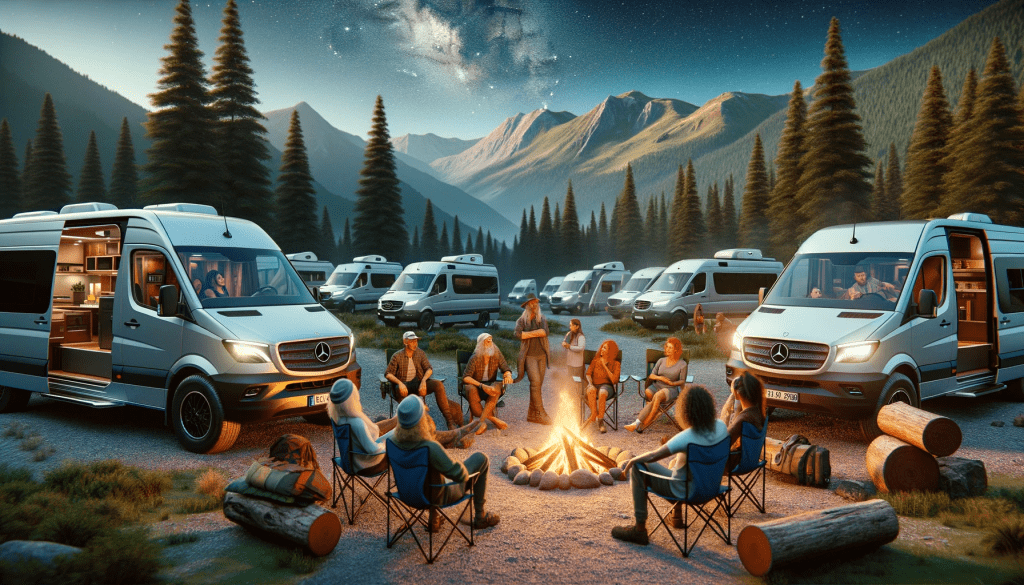
Real-Life Testimonials: The Class B RV Experience
From campfire tales to rooftop sunsets: Dive into inspiring stories from fellow adventurers who’ve embraced the Class B RV lifestyle.
-
-
Seek out the RV community: Popular RV Forums offer a wealth of advice, tips, and real-life experiences, showcasing a unique blend of freedom, convenience, and adventure.
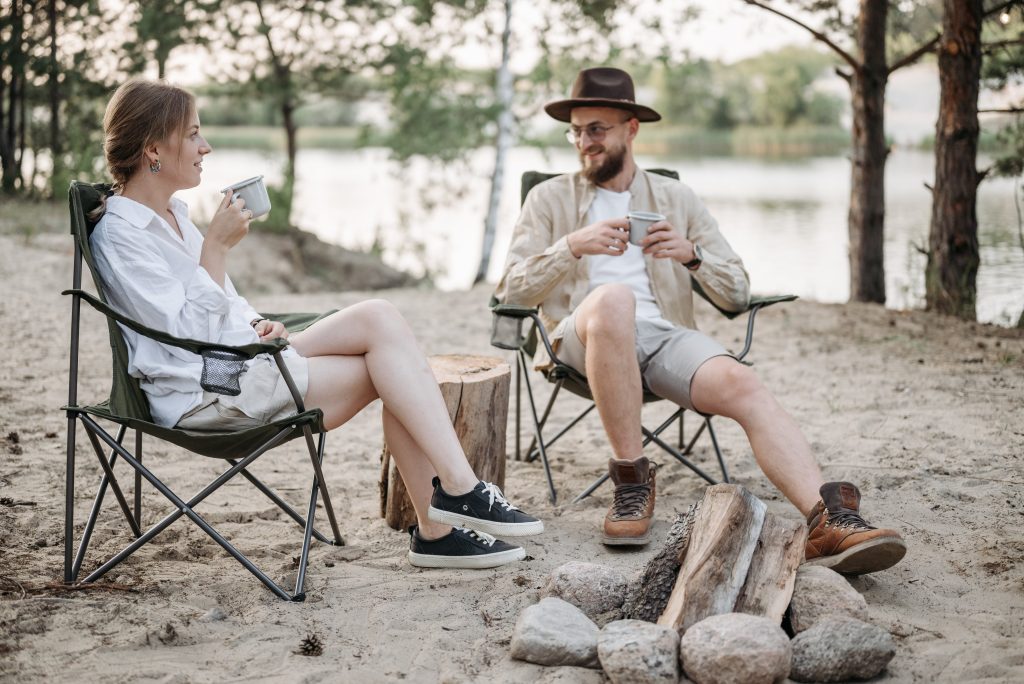
Living the Class B Lifestyle
Living Tiny, Living Smart: Making the Most of Your Class B RV
Your Class B RV isn’t just a vehicle, it’s a launchpad for endless adventures. But navigating a compact space requires some ingenuity. Here’s how to unlock the full potential of your tiny home on wheels:
Tiny Kitchen, Big Flavors
Compact cooking doesn’t have to mean flavorless meals. Embrace these tips:
- Master the art of one-pot wonders: From hearty stews to creamy pasta dishes, one-pot meals minimize cleanup and maximize flavor. Think chili, soups, stir-fries, and pasta bakes. Discover delicious recipes at Fresh Off The Grid.
- Invest in space-saving appliances: A pressure cooker can whip up tender meats in minutes, while a toaster oven offers baking and broiling capabilities without hogging counter space.
- Get creative with storage: Utilize magnetic knife strips, hanging shelves, and under-sink organizers to keep essentials within reach.
Smart Storage Solutions
Making the most of your limited space is key. Here’s how:
- Embrace foldable furniture: Opt for tables and chairs that fold flat or convert into sleeping bunks. Use collapsible bins and organizers for clothes, toiletries, and gear.
- Utilize every nook and cranny: Install overhead shelves above the driver’s and passenger’s seats, and consider under-bed storage compartments for bulky items.
- Hang it all: Hooks and hanging shelves are your best friends for towels, utensils, and even bikes.
DIY Maintenance Skills
Knowing the basics of RV maintenance can save you time and money on the road. Here’s a starter kit:
- Master essential tasks: Learn how to change a tire, check fluid levels, and troubleshoot basic electrical issues.
- Carry a well-stocked toolbox: Pack essentials like screwdrivers, pliers, duct tape, jumper cables, and fuses.
- Join online communities: Connect with other RV owners for expert advice and troubleshooting tips.
Capturing the Essence of Impromptu Adventures
The beauty of a Class B RV is its agility. Be open to:
- Unplanned detours: Discover hidden waterfalls, charming towns, or breathtaking vistas simply by following your whims.
- Finding hidden gems: Ditch the tourist traps and explore secluded beaches, local farmers’ markets, or quirky roadside attractions.
- Embracing the unexpected: A flat tire might lead to a friendly encounter with fellow travelers, and that rainy day could be the perfect excuse for a cozy movie night inside your snug RV.
Remember, your Class B RV is more than just a mode of transportation. It’s a canvas for creating countless adventures. So pack your creativity, a spirit of discovery, and these helpful tips, and get ready to make every mile count!
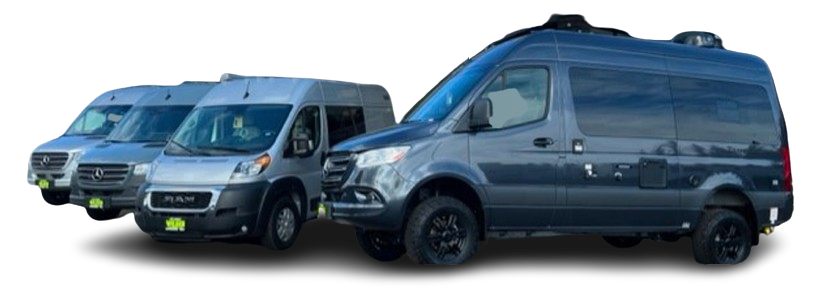
Exploring Your Options
Class B Bonanza: Finding Your Perfect Match
Welcome to the world of Class B RVs, your gateway to adventures big and small! But amidst the sea of sleek vans, choosing the right one can feel overwhelming. Worry not, adventurer, for this guide will help you navigate the different types and discover your perfect match!
Meet Your Match: The Class B Van Family
Each Class B boasts unique features, catering to diverse travel styles and needs. Let’s dive into the three main tribes:
1. High-Top Haven
Explore spacious, high-top Class B RVs with ample headroom and comfortable standing space at Grech RV.
- Strengths: Imagine standing tall, stretching your arms towards the sunlit ceiling. High-top Haven boasts generous headroom, ideal for taller folks or those who crave space to move and breathe. The extra height often translates to larger beds and more storage options, making them perfect for extended trips or families.
2. Low-Profile Prowler
- Strengths: Slip through city streets with the agility of a cat! Low-Profile Prowlers hug the pavement, offering superior fuel efficiency and nimbleness in tight spaces. Their compact size makes them ideal for urban adventures, weekend getaways, and solo explorers who value maneuverability.
3. Convertible Chameleon
- Strengths: Craving versatility? Then the Convertible Chameleon is your spirit animal! These clever vans feature adaptable furniture and layouts that magically morph from cozy living spaces to comfortable sleeping quarters. Ideal for couples who value both relaxation and exploration, and those who embrace spontaneous detours.
Narrowing Down your Choices:
Now, the fun begins! Explore a range of Class B RVs within each tribe to find the one that resonates with your soul. Consider these factors:
- Travel style: Are you a weekend warrior or a full-time nomad? Do you crave cityscapes or wide-open landscapes?
- Needs and preferences: Prioritize headroom, fuel efficiency, or flexible layouts? How much storage do you need?
- Budget: Be realistic about your financial limitations while factoring in long-term considerations like fuel costs and maintenance.
Remember, your Class B RV is more than just a vehicle; it’s a home on wheels, a partner in adventure, and an extension of your soul. Choose wisely, and get ready to hit the road with your perfect van match!
Bonus Tip:
Take advantage of RV shows, rental experiences, and online communities to test-drive different models and gather valuable insights before making your final decision. Happy van hunting!
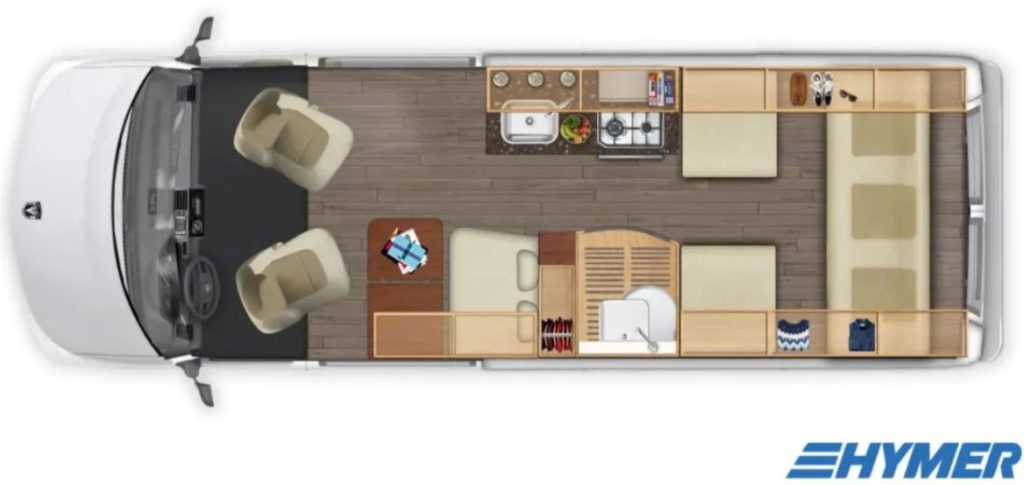
Don’t Be Fooled by the Footprint
Class B RVs might be compact on the outside, but step inside and be prepared to be amazed by their clever design and surprisingly spacious interiors. These tiny homes on wheels are packed with innovative features that maximize comfort and functionality, ensuring you can live life to the fullest on the road.
Sun-Kissed Sanctuaries:
- Natural Light: Forget cramped and dim RV interiors! Class B RVs boast strategically placed windows and skylights that flood the cabin with natural light, creating a cheerful and airy atmosphere. Imagine waking up to breathtaking sunrises or enjoying evening meals bathed in the warm glow of the sunset – all from the comfort of your cozy van.
- Sleek Design: Gone are the days of clunky RV interiors. Modern Class B RVs emphasize a minimalist aesthetic, utilizing clean lines, hidden storage solutions, and high-quality materials. This not only maximizes space but also creates a sophisticated and relaxing environment.
Culinary Conquests in a Compact Kitchen:
- Fully Equipped: Don’t let the size fool you! Class B RVs come with surprisingly well-equipped kitchens, featuring all the essentials for whipping up delicious meals on the road. Think mini fridge and freezer, two-burner stovetops, compact sinks, and even built-in microwaves and toaster ovens.
- Smart Storage: Every inch of space in a Class B kitchen counts. Ingenious storage solutions like pull-out drawers, overhead cabinets, and hidden compartments keep your pots, pans, utensils, and spices organized and easily accessible. No more rummaging through cluttered cabinets!
Bathroom Bliss, Tiny But Mighty:
- Surprisingly Spacious: Class B RVs prove that you don’t need a massive bathroom to enjoy comfort and convenience. These tiny but mighty spaces often feature full-functioning showers, toilets, and sinks, ensuring hygiene and practicality even on the most remote adventures.
Sweet Dreams on Wheels:
- Adaptable Sleeping Arrangements: Whether you’re a couple seeking a cozy nook or a family needing space for everyone, Class B RVs offer a variety of sleeping configurations. From plush fixed beds to innovative pop-up roofs with spacious mattresses, you’re sure to find the perfect setup for catching some restful Zzzs on the road.
So, don’t be fooled by the compact exterior of Class B RVs. Embrace the clever design that makes every inch count, transforming these tiny homes into spacious sanctuaries for adventure and relaxation. Get ready to experience the joys of living life large in a small package!
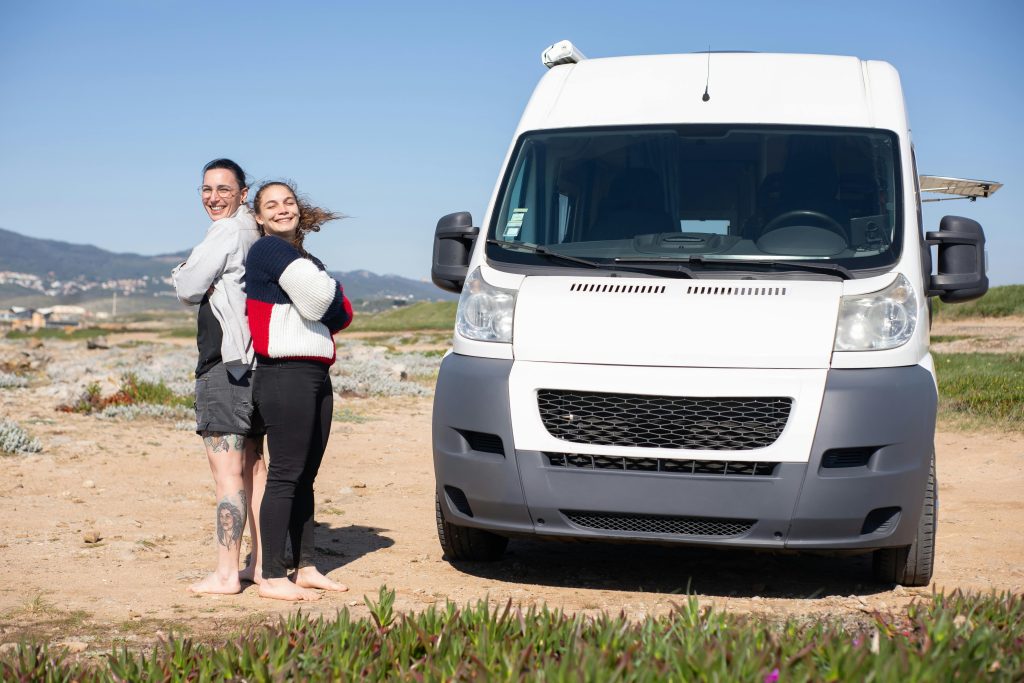
Hitting the Road
Your Guide to Buying and Maintaining Your Class B RV
Owning a Class B RV is more than just hitting the open road – it’s an investment in freedom and adventure. To make the most of your experience, consider this guide to navigating the buying process and keeping your tiny home on wheels in tip-top shape.
New vs. Used: Weighing the Wheels
Deciding between a shiny, new Class B and a seasoned companion can be a game-changer. Here’s a breakdown of the key considerations:
| Feature |
New Class B RVs |
Used Class B RVs |
| Cost |
Higher initial cost due to new condition. |
Lower initial cost, more budget-friendly. |
| Warranty |
Typically includes manufacturer’s warranty. |
Often lacks warranty; dependent on vehicle age. |
| Customization |
Options to customize features and specs. |
Limited customization; reliant on previous owner. |
| Potential Repairs |
Minimal; newer models have less wear and tear. |
Risk of unforeseen repairs; may have wear or outdated features. |
Weighing the Options:
- New Class B RVs: Perfect for those who crave the latest technology, comfort, and peace of mind of a warranty. Be prepared for the higher price tag.
- Used Class B RVs: A budget-friendly option for experienced adventurers. Research thoroughly, and factor in potential repair costs and outdated features.
Maintenance Tips:
Whether you choose new or used, proper maintenance is key to maximizing your RV’s lifespan and avoiding costly breakdowns. Here are some essential tips:
- Regular Check-ups: Schedule regular maintenance appointments with qualified RV technicians to ensure everything is running smoothly.
- DIY Skills: Equip yourself with basic repair knowledge for handling common issues like tire changes, battery checks, and water system troubleshooting.
- Keep a Handy Toolkit: Stock your RV with essential tools and spare parts for quick fixes on the road.
- Consult Online Communities: Connect with fellow Class B owners online for troubleshooting tips, maintenance advice, and recommended repair shops.
Remember, your Class B RV is an investment in adventure. By making informed buying decisions and proactively maintaining your vehicle, you can ensure your tiny home on wheels carries you towards countless unforgettable experiences. So buckle up, hit the road, and embrace the boundless possibilities of the Class B lifestyle!
Hit the Pavement, Find Your Path: Top Class B RV Models
The world is your oyster, and choosing the right Class B RV is your passport to adventure. But with so many options, where do you start? Fear not, intrepid wanderer, for we’ve handpicked a selection of top models, each tailored to a specific travel style:
For the Rugged Explorer:
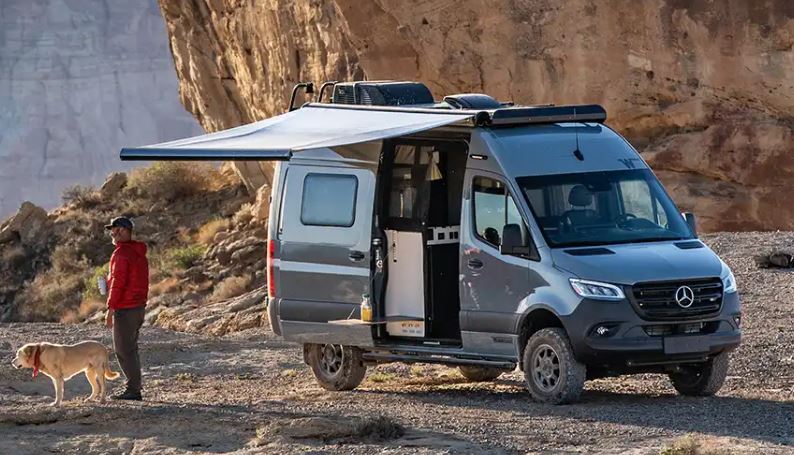
Image via Winnebago
Winnebago Revel: This beast boasts all-wheel drive, high ground clearance, and rugged construction, letting you conquer the unbeaten path with confidence. Imagine waking up to panoramic mountain views after traversing a dusty trail with ease.
For the Luxurious Traveler:
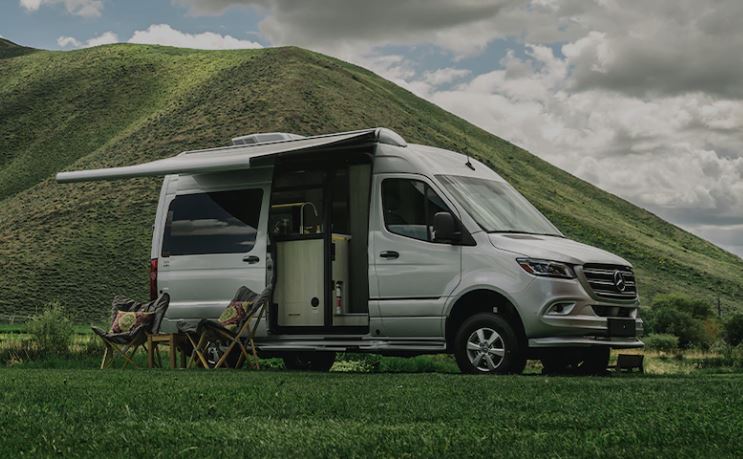
Image via Airstream
Airstream Interstate: Elegance meets adventure in this sleek, high-end RV. Premium finishes, spacious interiors, and top-notch amenities transform every journey into a first-class experience. Picture sipping champagne under the stars from your plush rooftop deck.
For the Eco-Conscious:
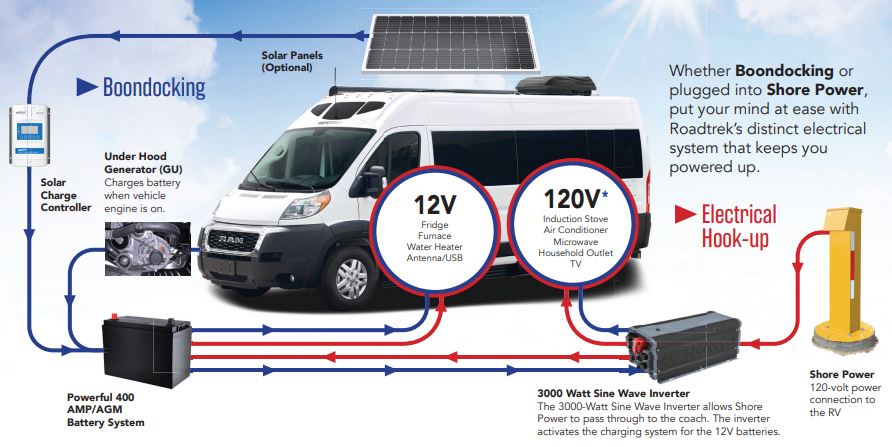
Image via Roadtrek
Roadtrek Zion: Embrace sustainability without sacrificing comfort. This eco-friendly model features solar panels, energy-efficient appliances, and recycled materials, allowing you to minimize your environmental footprint while exploring stunning landscapes. Breathe easy knowing you’re leaving a lighter tread.
Bonus Picks:
- The Family Adventure Rig: Look for models with bunk beds, convertible furniture, and ample storage, like the Pleasure-Way Lexor TS. Entertainment centers and outdoor movie projectors keep boredom at bay.
- The Solo Seeker Sanctuary: Compact vans like the Mercedes-Benz Sprinter Van offer maneuverability and a cozy haven for solo journeys. Imagine journaling beside a secluded beach with the ocean as your soundtrack.
Remember, your perfect Class B RV is out there waiting. Consider your travel style, budget, and desired features to narrow down your search. Research, test drive, and don’t be afraid to ask questions. Soon, you’ll be behind the wheel, ready to conquer any road and create memories that will last a lifetime. Happy wanderings!
Enhancing Your Adventure
Level Up Your Journey: Unleash the Potential of Your Class B RV
Your Class B RV is more than just a vehicle; it’s your window to adventure and your sanctuary on the road. But why settle for basic when you can customize it into the ultimate expression of your travel dreams? Here are some inspiring upgrades to transform your tiny home on wheels into a haven of comfort, functionality, and endless possibilities:
Solar Power Independence:
Solar Panels: Shed the shackles of campsite hookups and embrace the freedom of off-grid living! Harness the sun’s power with rooftop panels, generating clean energy to run your appliances and lights, even in remote locations. Imagine waking up to a breathtaking sunrise, knowing you’re powered by nature’s bounty.
Outdoor Adventure Ready:
Bike Racks and Kayak Mounts: Transform your RV into a base camp for outdoor exploration. Secure your bikes and kayaks with sturdy racks, and hit the trails or paddle crystal-clear waters with ease. Picture exhilarating mountain bike descents or tranquil kayak journeys, accessible right from your doorstep.
Upgraded Suspension:
Beefed-Up Suspension: Craving adventures beyond paved roads? Elevate your off-road capabilities with a high-performance suspension system. Conquer bumpy terrain with confidence, and access hidden campgrounds and breathtaking vistas off the beaten path. Imagine traversing dusty desert tracks or winding mountain passes with your trusty RV as your unwavering companion.
Tech Savvy Solutions:
Satellite Internet: Stay connected wherever you roam with a satellite internet antenna. Work remotely from stunning landscapes, stream movies under the stars, and share your adventures with the world – all in real-time. Picture editing photos from a cliff overlooking the ocean or video conferencing with colleagues amidst rolling hills.
Comfort and Convenience Enhancers:
Awning and Outdoor Furniture: Expand your living space with a retractable awning, creating a shaded oasis for outdoor dining and relaxation. Invest in comfortable camp chairs and a portable table, and transform any campsite into a cozy, open-air living room.
Smart Storage Solutions:
Cargo Organizers: Maximize space and minimize clutter with clever storage solutions. Utilize hanging organizers, under-bed drawers, and collapsible bins to keep your gear neatly stowed and readily accessible. Imagine a clutter-free interior that fosters tranquility and organization.
Remember, your Class B RV is a blank canvas. Let your imagination run wild and personalize it with upgrades that reflect your passions and adventures. With each thoughtful addition, you’ll not only enhance your comfort and functionality but also create a unique reflection of your nomadic spirit. So, hit the road, embrace the power of customization, and make your Class B RV an unforgettable extension of your adventure-filled life!
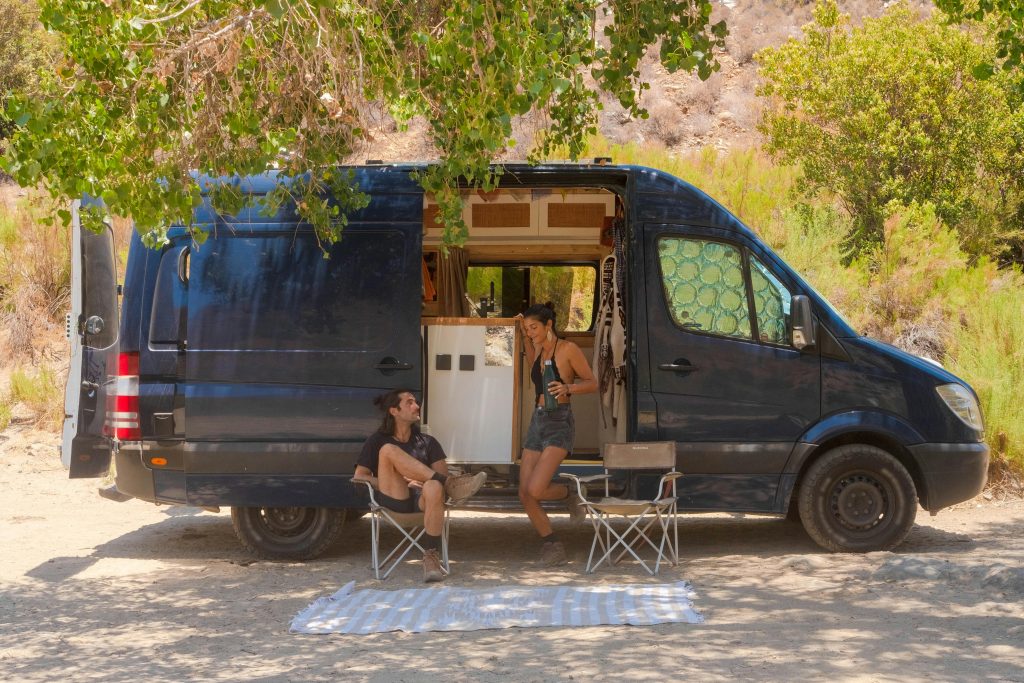
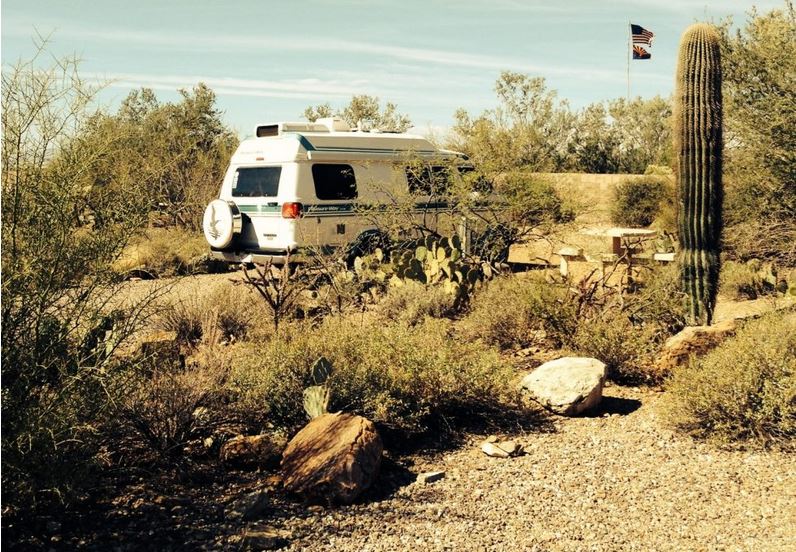
by Chuck Price | Aug 20, 2023 | Class B RV
Your Ultimate Guide to Compact RVing
Unleash your wanderlust and explore hidden gems with the agility and comfort of a Class B RV! This comprehensive guide, your one-stop shop for all things Class B RVing, empowers both seasoned nomads and curious newcomers to hit the road with confidence. Imagine spontaneous detours through charming towns, cozy nights under starlit skies, and the freedom to go wherever your adventurous spirit takes you – that’s the magic of Class B RV travel. Dive in and discover essential tips, expert advice, and inspiring ideas to turn your dream trip into reality.or many adventure seekers, Class B RVs are like a magic key unlocking a world of freedom and exploration. Unlike their larger counterparts, Class B RVs boast incredible maneuverability, allowing you to navigate charming towns, wind down scenic byways, and discover hidden gems off the beaten path. Say goodbye to gas station anxiety with their impressive fuel efficiency, putting more money in your pocket for unforgettable experiences.
Whether you’re a seasoned traveler yearning for a simpler, more nimble travel companion or a newcomer seeking an accessible RV adventure, Class B RVs deliver. Don’t compromise on comfort – these meticulously designed vans offer everything you need, from a well-equipped kitchen for culinary creations to a cozy sleeping area for restful nights under the stars. As adventure photographer Sarah Jones once said, “My Class B RV has become my adventure mobile, taking me to breathtaking landscapes I never thought I could reach.
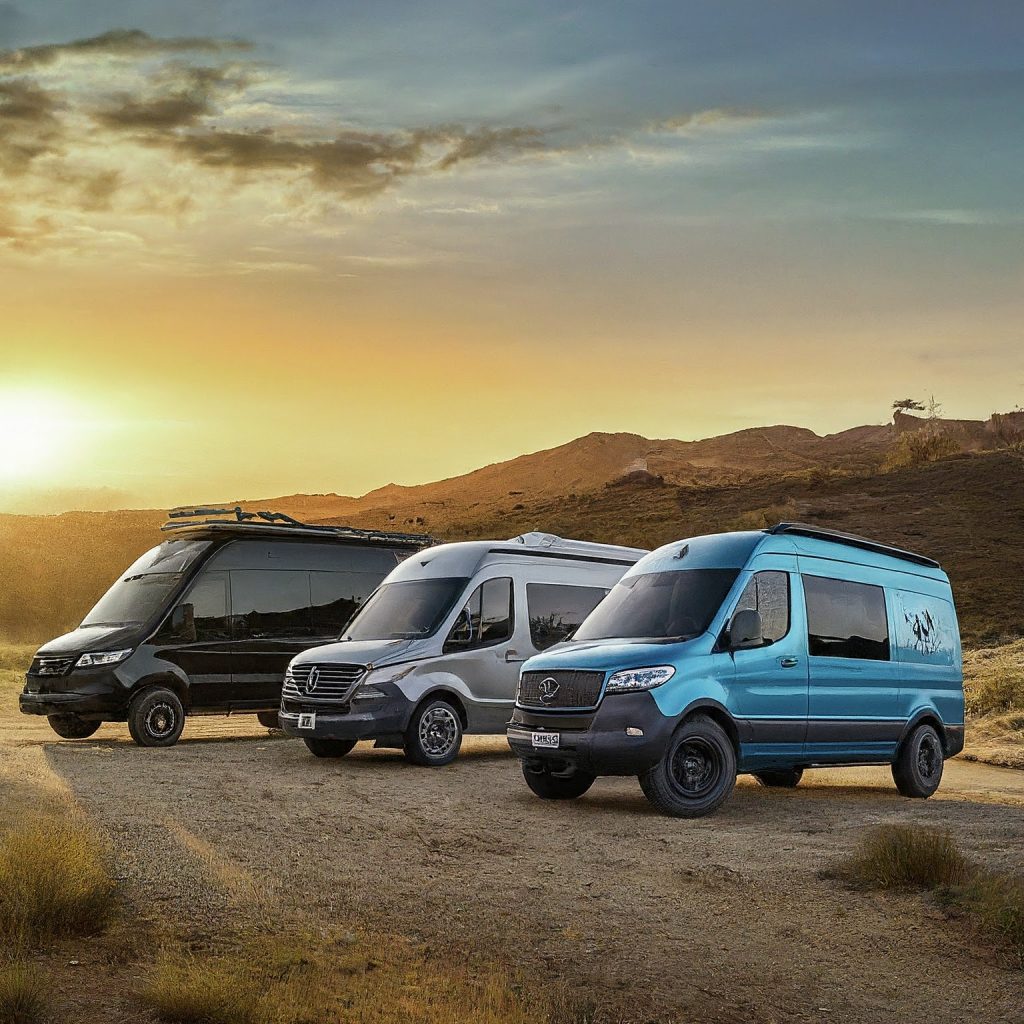
Class B RV Comparison Table
The road awaits, and your nimble Class B RV is the key to unlocking countless adventures. But before you hit the open highway, choosing the right van is crucial. Don’t worry, this guide will equip you with the essential factors to consider, ensuring your Class B perfectly complements your travel dreams and budget.
Size & Style:
- Compact Camper Vans: Ideal for solo adventurers or couples, these agile companions offer excellent fuel efficiency and navigate charming towns with ease. Think Dodge ProMaster or Mercedes-Benz Metris.
- Mid-Size Conversion Vans: Perfect for families or small groups, these vans provide more space and flexibility with pop-up roofs or fixed beds. Explore options like the Winnebago Solis or Pleasure-Way Lexor TS.
- Large Adventure Vans: Designed for extended explorations, these powerhouses boast off-road capabilities and ample amenities. Consider the Mercedes-Benz Sprinter 4×4 or the Leisure Travel Vans Serenity.
Think about your travel style: Will you be conquering off-the-beaten-path destinations or prioritizing cozy nights under the stars? How much space do you need for gear and comfort?
Features & Budget:
- Basic Vans: Budget-friendly options with essential amenities like a kitchenette and sleeping area. Consider the Ford Transit Connect or the Ram ProMaster City.
- Adventure-Ready Vans: Equipped for off-grid adventures with solar panels, roof racks, and rugged suspension. Explore the Winnebago Revel or the Sportsmobile Independence.
- Luxury Vans: Pamper yourself with premium finishes, top-of-the-line appliances, and spacious living areas. Look at the Airstream Interstate or the Mercedes-Benz Sprinter Executive.
Remember, your budget plays a key role. Consider upfront costs, potential long-term savings, and how your chosen features align with your travel plans.
Rent or Buy?
Whether renting or buying depends on your individual needs. Consider factors like:
- Trip Duration: Short trips or trying out the lifestyle? Renting might be ideal. Frequent or extended adventures? Buying could offer savings.
- Budget: Lower upfront cost for renting, but monthly/weekly expenses add up. Buying requires a higher initial investment but offers long-term ownership.
- Frequency of Use: Occasional use? Renting might be more cost-effective. Regular travelers might benefit from buying.
Ultimately, the choice is yours! Research, compare options, and don’t be afraid to ask questions.
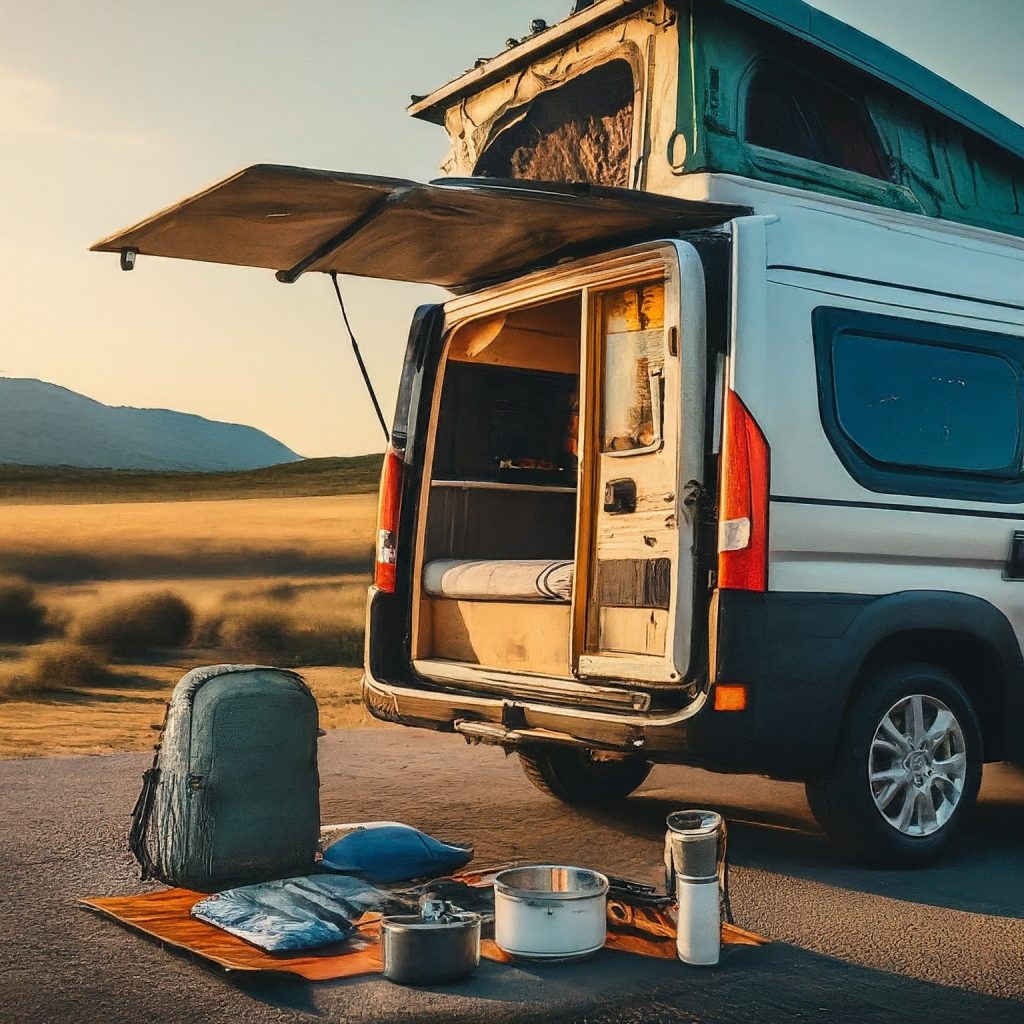
Pack Smart, Live Large: Class B RV Essentials
Hitting the road in your Class B RV is all about freedom and adventure, but with limited space, packing efficiently is key. Fear not! This guide equips you with essential items and space-saving hacks to maximize your living space and minimize clutter.
Essentials Checklist: Adapt to your personal style.
Clothing:
- Lightweight, quick-drying clothes: Opt for versatile pieces that can be layered for different weather conditions.
- Comfortable shoes: Pack for your activities, whether it’s hiking boots for exploring trails or sandals for kicking back at the campsite.
- Rain gear: Be prepared for unexpected downpours with a waterproof jacket and pants.
Kitchen:
- Compact cookware: Choose pots and pans that nestle together or multi-function options like a pot that doubles as a frying pan.
- Reusable dishes and utensils: Ditch disposables and opt for lightweight, reusable alternatives.
- Spices and condiments: Add flavor to your meals with your favorite spices and sauces.
- Non-perishable food staples: Stock up on items like pasta, rice, and canned goods for quick and easy meals.
Hygiene:
- Biodegradable toiletries: Minimize your environmental impact with eco-friendly options.
- Quick-drying towel: Save space with a microfiber towel that dries quickly.
- First-aid kit: Be prepared for minor injuries with essential supplies.
- Medications: Pack any medications you regularly take.
Sleeping:
- Breathable bedding: Ensure comfortable sleep with lightweight sheets and blankets.
- Lightweight pillows: Find compact pillows that offer good support.
- Compact sleeping bags (for colder climates): Choose a sleeping bag with the appropriate temperature rating for your intended destinations.
RV Gear:
- Leveling blocks and tire wedges: Ensure your van sits level for a comfortable stay.
- Extension cords and hoses: Connect to campgrounds and access water sources.
- Multi-tool: Be prepared for minor repairs with a versatile tool kit.
- Emergency kit: Pack essential items for unexpected situations.
Space-Saving Savvy:
- Multi-tasking marvels: Look for items that serve multiple purposes, like a travel mug that doubles as a water bottle.
- Roll it up: Embrace the art of rolling clothes to save space and prevent wrinkles.
- Compression companions: Utilize compression bags to shrink bulky items like blankets and pillows.
- Downloadable Checklists: Find comprehensive, categorized checklists online to ensure you don’t miss anything.
Remember, packing light is about choosing the right gear and using clever organization techniques. This guide and the downloadable checklists will help you pack smart and live large on your Class B RV adventure!
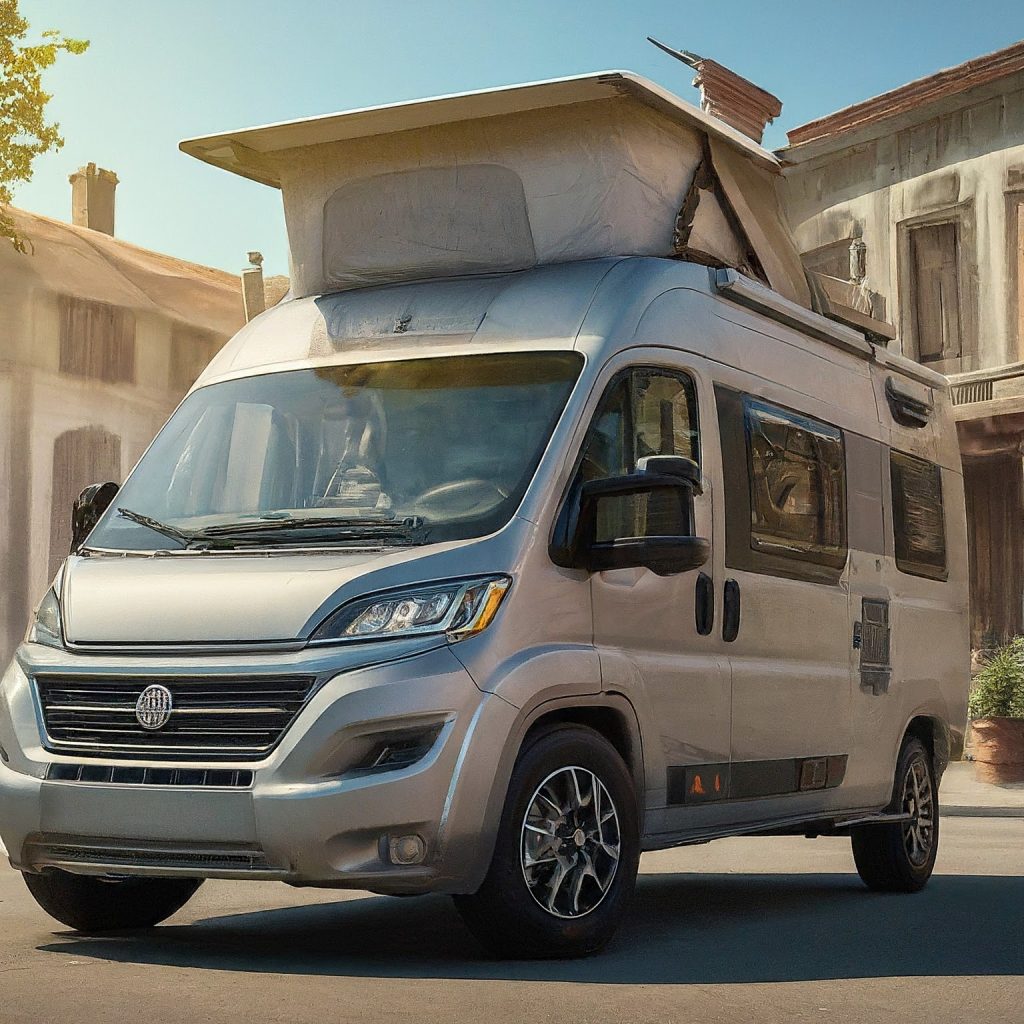
Taking the Wheel: Adventure Awaits
Get ready to navigate the open road with confidence! While driving basics apply, Class B RVs offer unique dynamics. Their nimble size allows you to conquer winding roads and squeeze into charming town centers, but it also requires adjusting your driving approach. Master blind spots, anticipate wind sway, and hone your parking skills – practice makes perfect for a smooth journey.
Unique Destinations for Your B:
- National Parks & Monuments: Embrace the grandeur of Yosemite, Yellowstone, or Zion in your compact camper, accessing scenic overlooks and hidden trails often off-limits to larger RVs.
- Coastal Charm: Cruise the Pacific Coast Highway, park directly on the beach in California, or explore hidden coves along the Atlantic seaboard, enjoying ocean breezes and breathtaking sunrises.
- Foodie Delights: Savor farm-to-table eats in Napa Valley, sample Louisiana’s vibrant culinary scene, or explore Oregon’s renowned wineries – your B lets you park near the action and indulge in local flavors.
- Off-the-Grid Adventures: Venture deep into national forests like Montana’s Flathead or Colorado’s San Juan Mountains, find dispersed camping spots for secluded serenity, and reconnect with nature under starry skies.
- Quirky Charm: Discover unique destinations like quirky roadside attractions, charming small towns with vibrant festivals, or historical landmarks – your B allows for spontaneous detours and unexpected discoveries.
Camping Options to Match Your Style:
- Full-Service Campgrounds: Enjoy convenient amenities like laundry facilities, swimming pools, and organized activities, ideal for families or those seeking a resort-style experience.
- National Park Campgrounds: Immerse yourself in nature with basic amenities like restrooms and picnic tables, offering a balance of convenience and access to natural wonders.
- Dispersed Camping: Embrace true solitude and off-the-grid living with minimal or no amenities, often requiring self-sufficiency and responsible Leave No Trace practices.
- Harvest Hosts: Park overnight at unique farms, wineries, breweries, and more in exchange for patronizing their business – a delightful way to connect with local producers and enjoy unique settings.
- Boondocking: Take advantage of free overnight parking on public lands like BLM-managed areas, following regulations and respecting the environment.
Remember: Planning and research are key. Choose destinations and campgrounds that align with your desired amenities, budget, and activities. Check regulations, availability, and weather conditions before setting out.
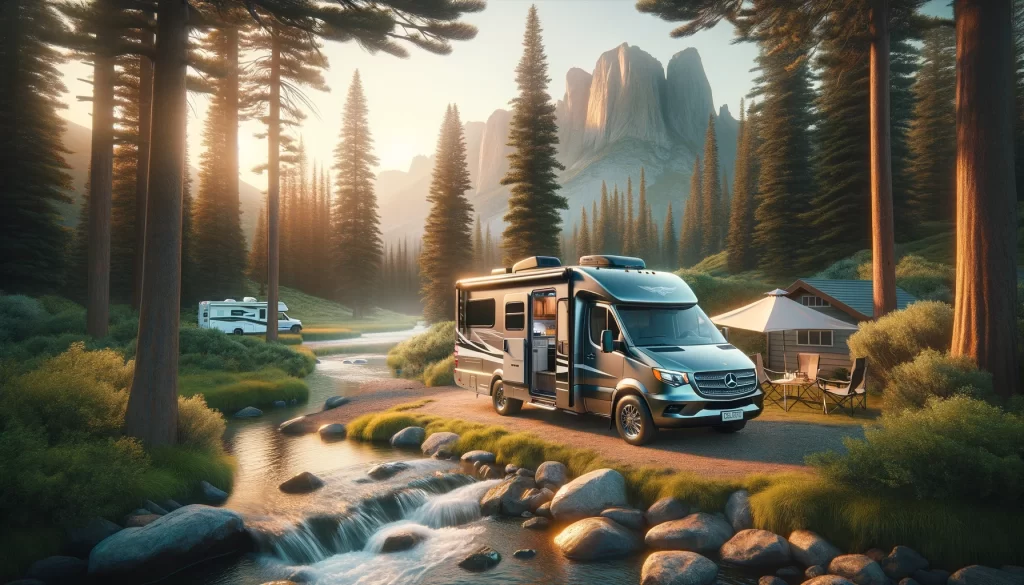
Finding Your Perfect Oasis: Campsite Guide
Your Class B adventure needs its ideal resting place, a campsite that reflects your desires and enhances your experience. But with countless options, choosing the perfect spot can feel overwhelming. Let’s break it down to key factors:
Amenities:
- Basic comfort: Consider essentials like restrooms, showers, and laundry facilities, or opt for the simplicity of dry camping and self-sufficiency.
- Activities & entertainment: Do you crave swimming pools, playgrounds, and organized events, or prefer quiet contemplation by a campfire?
- Connectivity: Need reliable internet access for remote work or social media updates? Choose campgrounds with Wi-Fi or cellular service reception.
Budget:
- Free vs. paid camping: Dispersed camping offers free options, while full-service campgrounds have fees that vary based on amenities and location.
- Membership programs: Explore programs like Harvest Hosts or Thousand Trails for special rates and unique campsite options.
- Extra expenses: Factor in fuel costs, park entrance fees, and any additional charges for activities or amenities.
Location:
- Proximity to your desired activities: Beachfront escapes, mountain adventures, or vibrant city access – choose a location that facilitates your travel goals.
- Scenery and ambiance: Do you envision breathtaking vistas, peaceful forest settings, or vibrant community vibes? Select a campsite that matches your desired atmosphere.
- Weather considerations: Research average temperatures, precipitation levels, and potential for extreme weather at your chosen destination.
Additional Resources:
- RV camping apps: Explore apps like The Dyrt, Campendium, or Allstays for detailed campground information, reviews, and booking options.
- RV websites: Utilize resources like Go RVing, Harvest Hosts, or Hipcamp for comprehensive listings, tips, and community recommendations.
- Guidebooks and forums: Refer to regional RV guidebooks or online forums for specific campsite insights and local knowledge.
Remember: Research is key! Read reviews, compare amenities, and factor in your preferences to find the campsite that perfectly complements your Class B adventure. Don’t hesitate to adjust your plans based on availability and weather conditions.
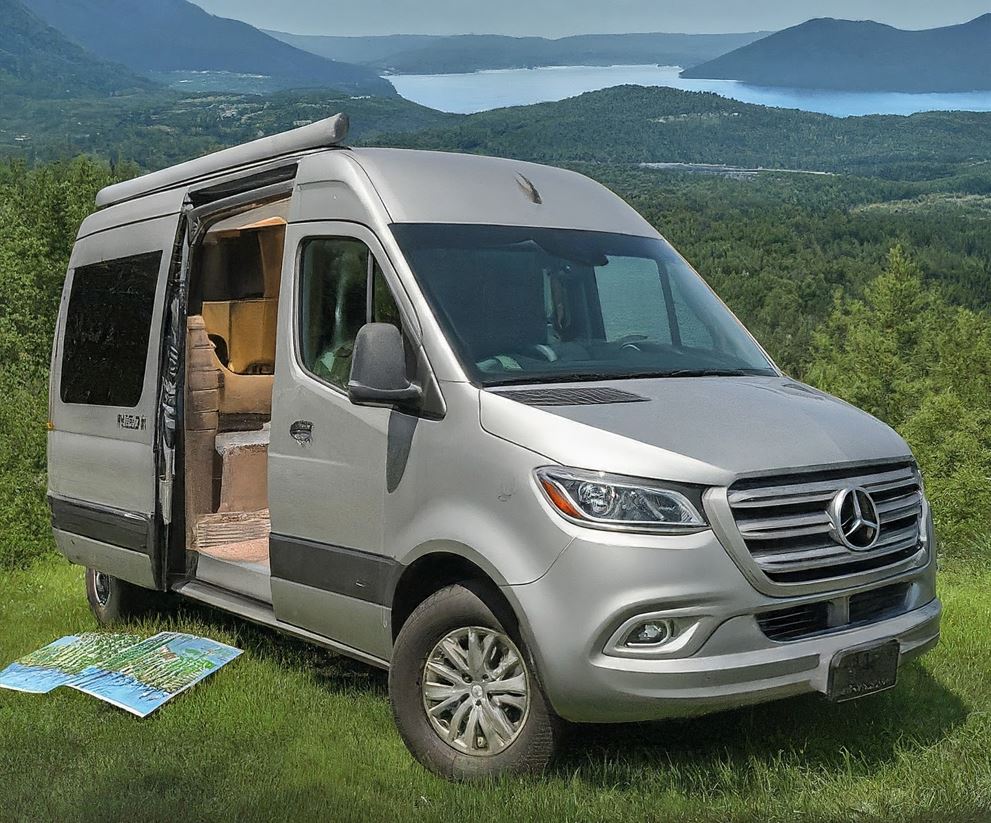
Essential Tips for Your Class B Odyssey
Your Class B adventure should be filled with memories, not mishaps. Here are key safety pointers to keep you confident and prepared on the road:
Vehicle Readiness:
- Regular maintenance: Ensure your van is in top condition with preventive maintenance and pre-trip inspections,
- Tire Pressure: regularly check and adjust tire pressure according to manufacturer recommendations and weather conditions.
- Emergency kit: Pack essential items for breakdowns, injuries, and unexpected situations.
- Roadside assistance: Consider membership in services like AAA or Good Sam for added peace of mind.
Navigation & Planning:
- Trip planning: Research routes, road conditions, weather forecasts, and campsite availability.
- Share your itinerary: Inform loved ones of your travel plans and expected arrival times.
- GPS & offline maps: Rely on both GPS and offline maps for reliable navigation, especially in remote areas.
On the Road:
- Defensive driving: Be mindful of other vehicles, anticipate their actions, and maintain safe distances.
- Rest and alertness: Avoid fatigued driving. Take breaks, plan for adequate sleep, and share driving duties if possible.
- Weather awareness: Stay updated on weather warnings and adjust your plans accordingly.
Campsite Security:
- Lock valuables: Secure belongings both inside and outside your van when unattended.
- Be aware of surroundings: Trust your instincts and report any suspicious activity to campground staff or authorities.
- Fire safety: Follow camping fire regulations and practice responsible campfire management.
Remember: Safety is a shared responsibility. Be courteous to other travelers, respect the environment, and always prioritize your well-being. For more detailed information, explore resources like the National Park Service website or RV safety guidelines by reputable organizations.
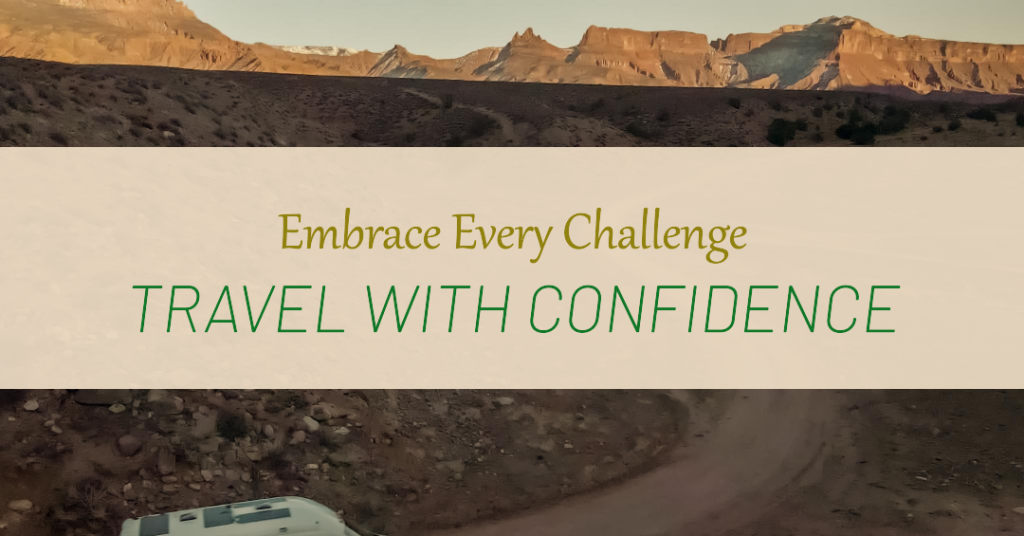
Embracing Challenges & Detours
Hitting the open road in your Class B RV promises freedom and adventure, but the journey inevitably presents challenges. From unexpected breakdowns to changing weather, detours off the planned route, and even the occasional bout of cabin fever, resilience is key. But worry not, for these challenges are interwoven with the unique joys of flexible Class B travel:
Anticipate the Bumps:
- Mechanical issues: Regular maintenance minimizes risks, but be prepared for potential breakdowns with an emergency kit and roadside assistance.
- Weather woes: Research weather patterns and have gear for varied conditions. Embrace cozy nights snuggled inside when storms rage outside.
- Finding the perfect campsite: Not every spot will be ideal. Embrace the flexibility of your B to adjust plans and seek new havens.
Embrace the Unexpected:
- Detours and spontaneity: The beauty of Class B travel lies in its agility. Embrace unplanned stops, charming towns, and scenic detours that enrich your journey.
- Meeting fellow travelers: Share stories, swap tips, and build camaraderie with fellow RVers you encounter along the way.
- Learning as you go: Every challenge is an opportunity to learn and grow. Embrace the problem-solving spirit and adapt to ever-changing situations.
Proactive Planning Makes Perfect:
- Research alternate routes and points of interest before your trip.
- Download offline maps and resources like campground directories for peace of mind.
- Embrace the open road and allow new experiences to arise – sometimes the best adventures are unplanned!
Remember: The journey is as important as the destination. Embrace the challenges as part of the adventure, and find joy in the flexibility and unexpected delights that unfold on your Class B odyssey.
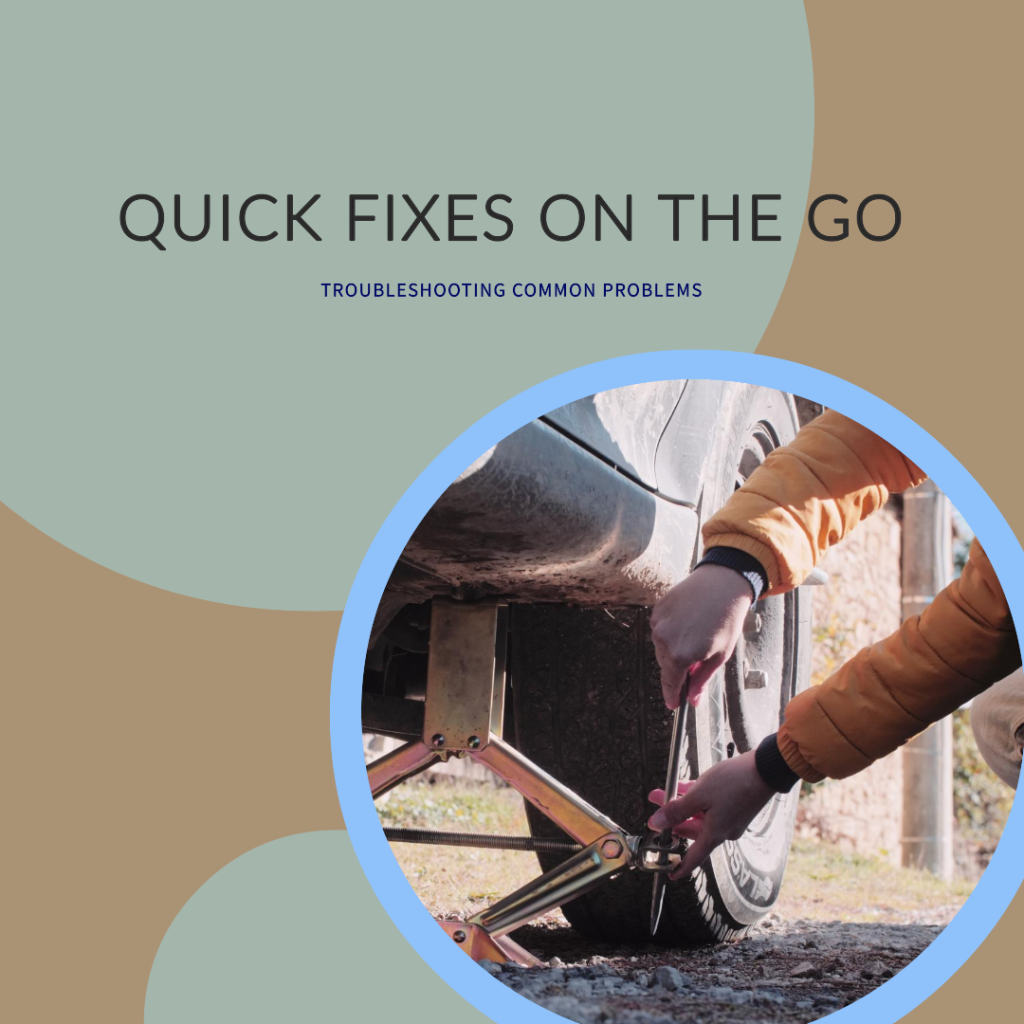
Troubleshooting Common Problems:
Your Class B adventure shouldn’t be derailed by minor issues. Here are some common problems and quick fixes to keep you rolling:
- Flat tire: Learn how to safely change a tire or have roadside assistance on hand.
- Dead battery: Jump-start your battery or consider having a portable jump starter and learning how to use it.
- Overheating: Pull over safely, turn off the engine, and let it cool down. Check coolant levels and ensure proper airflow.
- Plumbing issues: Identify the source of the leak and attempt basic repairs, or seek professional help at an RV dealership or campground.
- Appliance malfunctions: Refer to user manuals for troubleshooting tips or seek professional assistance if needed.
Remember, prevention is key. Regular maintenance and learning basic troubleshooting skills can help you address minor issues before they become major inconveniences.
RV Etiquette: Responsible & Respectful Travel
Your Class B journey should leave a positive impact wherever you roam. Here are some key etiquette tips to remember:
- Respect the environment: Leave no trace, minimize waste, and dispose of wastewater responsibly at designated dump stations.
- Be mindful of noise: Respect fellow campers and the surrounding community by limiting noise levels, especially at night.
- Obey campground rules: Familiarize yourself with and adhere to posted regulations for everyone’s enjoyment and safety.
- Practice responsible pet ownership: Keep your furry companions leashed, clean up after them, and be mindful of noise and behavior.
- Share the road: Drive defensively, yield to larger vehicles, and be courteous to other travelers.
By following these simple guidelines, you can contribute to a positive and responsible RVing community, ensuring a pleasant experience for everyone.

Conclusion: Your Class B RV Adventure Awaits!
Hitting the open road in your Class B RV is more than just a vacation; it’s a commitment to freedom, flexibility, and creating unforgettable memories. You’ve taken the first steps by exploring this guide, and now it’s time to turn your dreams into reality!
Remember the freedom you’ll savor:
- No more rigid itineraries: Explore hidden gems and chase spontaneous detours.
- Your home on wheels: Unpack once and wake up to stunning new views every day.
- Adventure at your fingertips: Hike remote trails, explore charming towns, and embrace the unexpected.
Ready to plan your escape?
- Fuel your inspiration: Research destinations, browse online communities, and connect with seasoned RVers for tips and tricks.
- Start planning: Utilize recommended resources like apps, websites, and guidebooks to find campsites, map your route, and estimate costs.
- Stay informed: Download offline maps, research local regulations, and subscribe to weather alerts for peace of mind.
Most importantly, embrace the journey:
- Adapt and thrive: Unexpected detours and challenges are part of the adventure. See them as opportunities to grow and create lasting memories.
- Connect with nature: Immerse yourself in the beauty of the outdoors, appreciate the simple moments, and leave no trace.
- Share the joy: Invite friends and family along, connect with fellow RVers, and share your experiences with the world.
Remember, the open road is waiting for you. With your Class B RV as your trusty companion, a spirit of adventure, and this guide as your starting point, you’re ready to embark on an unforgettable journey. Get out there, explore, and live the Class B RV dream!
Additional Resources:
Featured Image Credit: pxfuel
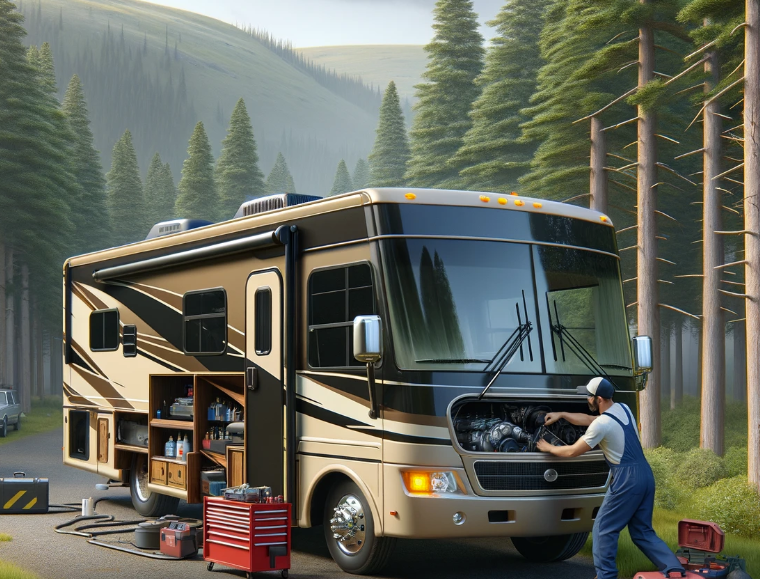
by Chuck Price | Jul 12, 2023 | Class B RV
The Secret to to Hassle-free Travel
Regular maintenance plays a crucial role in keeping your Class B RV in optimal condition. By implementing a practical maintenance routine, you can ensure the safety of your travels, extend the longevity of your vehicle, and save significant costs in the long run.
When it comes to Class B RVs, neglecting maintenance can lead to various safety issues, including mechanical failures and breakdowns on the road. By conducting regular inspections and servicing, you can identify potential problems early on and address them before they escalate, providing you with peace of mind during your adventures.
In addition to safety, proper maintenance also extends the lifespan of your Class B RV. Regularly checking and maintaining essential components such as the engine, electrical systems, tires, and plumbing ensures that your vehicle continues to perform at its best for many years to come.
One of the most significant benefits of maintaining your Class B RV is the potential cost savings. By investing in routine upkeep and following manufacturer guidelines, you can avoid costly damages that occur due to neglect. Preventative measures such as oil changes, filter replacements, and regular inspections are generally more affordable than dealing with unexpected breakdowns and major repairs.
Overall, a practical maintenance guide for your Class B RV is an indispensable resource that emphasizes the importance of regular servicing. By prioritizing maintenance, you can enhance the safety of your travels, extend the lifespan of your vehicle, and save significant costs in the long run.
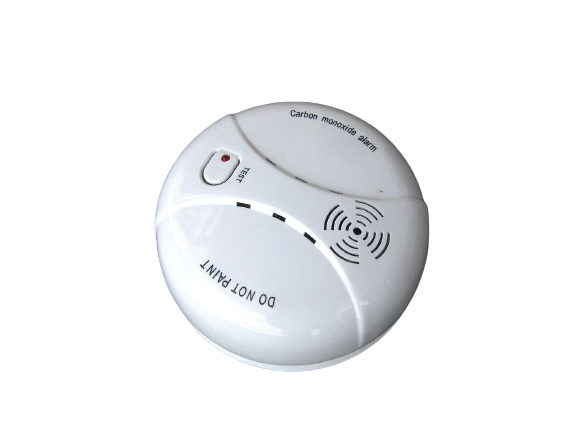 Safety and Emergency Preparedness
Safety and Emergency Preparedness
Ensuring the safety of yourself and your loved ones should always be a top priority when it comes to owning and maintaining your Class B RV. Implementing proper safety measures and being prepared for emergencies can make a significant difference in avoiding accidents or dealing with unforeseen situations on the road. Here are some essential safety and emergency preparedness tips for your Class B RV:
1. Maintaining and Testing Fire Extinguishers
A fire extinguisher is a crucial safety device that should always be present in your RV. Regularly inspect your fire extinguisher to ensure it is in good working condition and not expired. Follow the manufacturer’s instructions on how to perform the inspection and testing. Make sure everyone on board knows where the fire extinguisher is located and how to use it properly in case of an emergency.
2. Installation and Regular Maintenance of Carbon Monoxide Detectors
Carbon monoxide (CO) is an odorless and colorless gas that can be fatal if inhaled in high concentrations. Install carbon monoxide detectors in your RV, especially near sleeping areas. Test them regularly to ensure they are functioning correctly. Replace the batteries as needed and replace the detectors as recommended by the manufacturer.
3. Keeping a Well-Stocked First Aid Kit for RV Trips
A first aid kit is essential for any RV trip. It should contain basic medical supplies such as bandages, antiseptic wipes, adhesive tape, pain relievers, tweezers, and emergency contact information. Check your first aid kit regularly to restock any missing or expired items. Be familiar with the contents and how to use them.
4. Emergency Procedures While on the Road
Before hitting the road, familiarize yourself with emergency procedures specific to your Class B RV. Know how to safely pull over and secure your RV in case of a breakdown or mechanical issue. Keep a list of emergency contact numbers, including roadside assistance services. In the event of an emergency, remain calm and follow the necessary steps to ensure your safety and the safety of others.
Remember, practicing safety measures and being well-prepared for emergencies can significantly minimize the risks and enhance your overall RVing experience. Stay vigilant and prioritize safety to fully enjoy your Class B RV adventures!
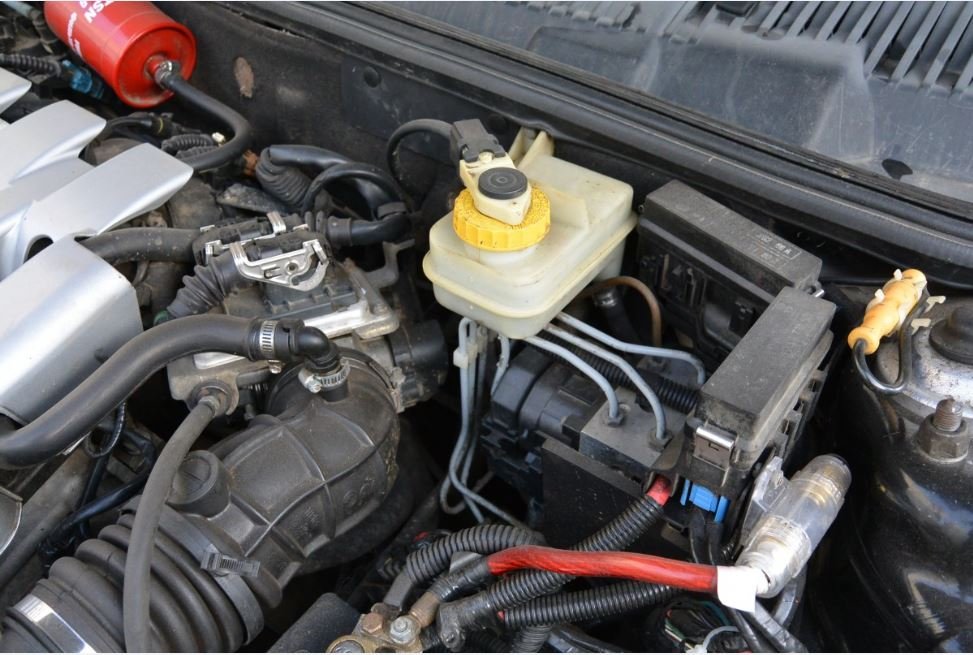
Image from PxHere
Engine and Vehicle Systems
Understanding the components of the RV’s engine & vehicle systems
When it comes to maintaining your Class B RV, it’s important to have a good understanding of its engine and vehicle systems. By familiarizing yourself with these components, you can easily identify any potential issues and address them before they become major problems. Let’s take a closer look at some key components you should know about:
- Engine: The heart of your RV, the engine powers your vehicle and runs on either gasoline or diesel fuel. It’s crucial to regularly check the oil level, change oil and oil filters as recommended by the manufacturer, and keep an eye on the engine temperature.
- Transmission: Responsible for transferring power from the engine to the wheels, the transmission needs regular maintenance, including fluid checks and changes.
- Brakes: Your RV’s braking system is essential for safety. Regularly inspect the brake pads, rotors, and brake fluid levels to ensure optimal performance.
- Suspension: The suspension system helps provide a smooth ride. Periodically inspect the shocks, struts, and other suspension components for any signs of wear or damage.
- Tires: Proper tire maintenance is crucial for safety and fuel efficiency. Check the tire pressure regularly, rotate the tires as recommended, and make sure they are properly aligned.
Cooling system maintenance procedures & coolant replacement
Maintaining a healthy cooling system is vital to prevent overheating and engine damage. Here are some maintenance procedures to follow:
- Regularly check the coolant levels and top-up if necessary.
- Inspect the radiator and hoses for leaks or damage.
- Flush and replace the coolant as per the manufacturer’s guidelines.
- Ensure the radiator fan is functioning properly.
Fuel system maintenance, including fuel filters and additives
To ensure optimal performance of your RV’s fuel system, follow these maintenance tips:
- Regularly inspect and replace fuel filters as recommended by the manufacturer.
- Add fuel additives periodically to keep the fuel system clean and prevent issues caused by ethanol and other contaminants.
- Keep an eye on fuel tank ventilation to prevent vapor lock issues.
Electrical system inspection and troubleshooting techniques
The electrical system plays a crucial role in your RV’s functionality. Here’s how you can keep it in top shape:
- Regularly inspect the battery terminals and clean them if necessary.
- Check the battery voltage and charge it if needed.
- Inspect and tighten all electrical connections.
- Use a multimeter for troubleshooting electrical issues.
Exhaust system maintenance and emissions testing requirements
The exhaust system not only helps with the performance of your RV but also ensures compliance with emissions regulations. Here’s how to maintain it:
- Inspect the exhaust system regularly for leaks, rust, or damage.
- Replace any worn-out or damaged components.
- Ensure that your RV meets the emissions standards specific to your area by getting it tested
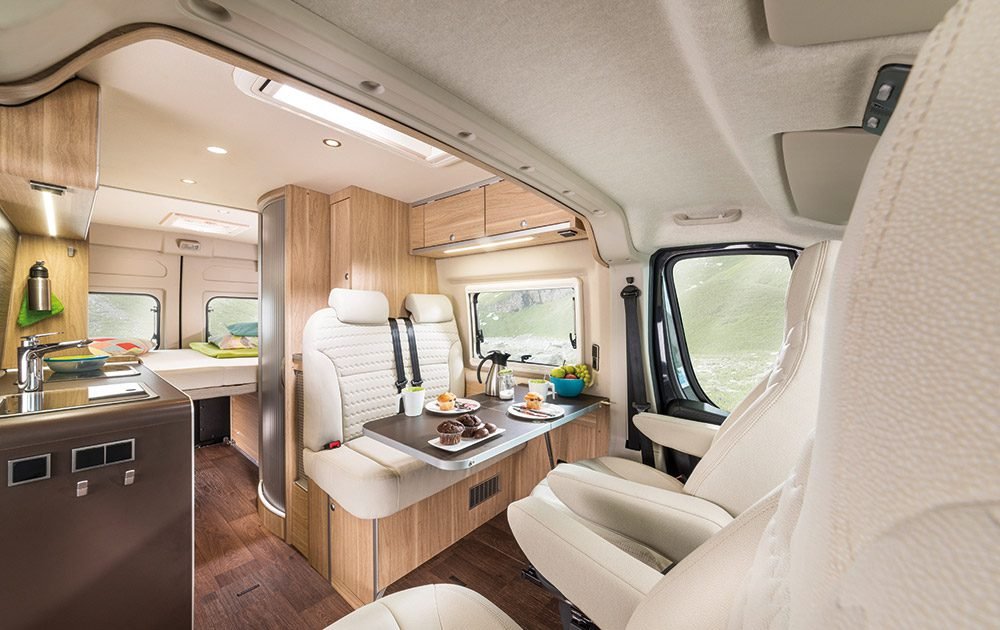
Interior Maintenance
- Cleaning and preserving amenities, appliances, and furniture: Keeping the interior of your Class B RV clean and preserved helps maintain its condition and prolong its lifespan. To ensure effective cleaning and preservation, consider the following:
- Use mild, non-abrasive cleaners appropriate for the materials in your RV.
- Regularly dust and vacuum to remove dirt and debris.
- Wipe surfaces with a damp cloth to eliminate stains and spills.
- Apply protective coatings, such as fabric or leather protectants, to upholstery and furniture to prevent staining and cracking.
- Occasionally deep clean carpets and upholstery using a steam cleaner or professional cleaning service.
- Clean and maintain appliances as per the manufacturer’s instructions.
Exterior Maintenance
- Cleaning, repairing damages, and weather protection: Proper exterior maintenance is vital for maintaining your Class B RV’s integrity and longevity. Here are some crucial maintenance tasks:
- Regularly wash and wax the exterior to protect the paint from fading and damage.
- Inspect windows, doors, roof, awning, slide-outs, and leveling systems for any signs of wear or damage. Promptly repair or replace as necessary.
- Maintain the seals around windows, doors, vents, and hatches to prevent water leakage.
- Use a gentle cleanser recommended for RV use and follow the manufacturer’s guidelines for cleaning the exterior, paying special attention to areas prone to mold and mildew.
- Repair any common exterior damages like scratches, dents, or cracks using suitable methods and materials.
- Use RV-specific covers when storing your Class B RV for extended periods to shield it from rain, snow, and UV rays.
- Apply UV protectant to the exterior surfaces to prevent fading and cracking due to sun exposure.
- Park in shaded areas whenever possible to minimize heat damage.
By performing these maintenance tasks regularly, you can ensure that your Class B RV remains in excellent condition and lasts for many years, providing you with countless enjoyable adventures.
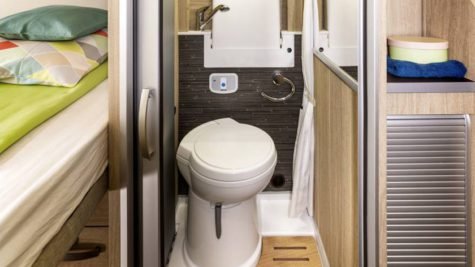
Plumbing and Water Systems
Maintenance requirements for the RV’s plumbing system
Maintaining the plumbing system in your Class B RV is essential to ensure a smooth and hassle-free trip. Regular upkeep will prevent potential issues and keep everything in working order.
Regular inspection of water tanks, fixtures, and pipes
Inspecting your water tanks, fixtures, and pipes on a regular basis will help you identify any signs of wear and tear or potential leaks. Look for cracks, loose fittings, or any other visible damage that could lead to bigger problems down the road.
- Check the water tanks for any leaks or signs of corrosion.
- Inspect the faucets, showers, and toilets for proper functioning and any leaks.
- Examine the pipes for any signs of leaks, punctures, or loose connections.
- Ensure that all valves, including the water pump, are working correctly.
Winterizing the plumbing system and preventing freeze-ups
During the colder months, it is crucial to winterize your RV’s plumbing system to prevent freeze-ups. Freezing temperatures can cause significant damage to your pipes and fixtures.
- Drain all water from the tanks, pipes, and water heater.
- Use an RV antifreeze to protect the plumbing system from freezing.
- Insulate any exposed pipes or hoses to prevent them from freezing.
Tips for preventing leaks and troubleshooting common issues
Water leaks can be a common issue in RVs. Being proactive in preventing leaks and knowing how to troubleshoot common problems can save you time and money.
- Regularly check for leaks around faucets, toilets, and water lines.
- Ensure all connections are tight and secure.
- Use plumbing sealant or tape to fix any small leaks.
- If you encounter a major leak or plumbing issue, consult a professional to avoid causing further damage.
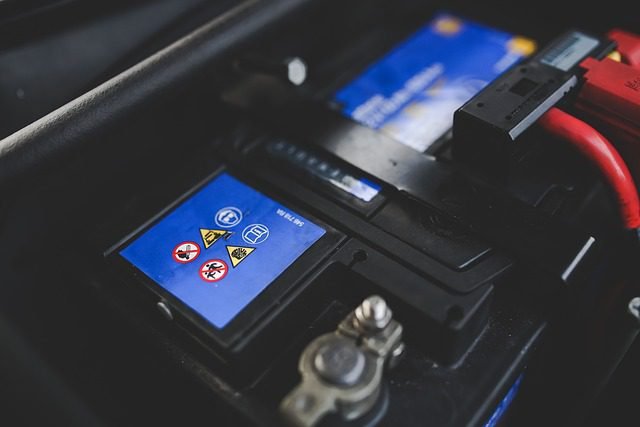 Image by Karolina Grabowska from Pixabay
Image by Karolina Grabowska from Pixabay
Electrical System and Appliances
Keeping your Class B RV’s electrical system and appliances in top shape is crucial for a comfortable and hassle-free travel experience. From battery maintenance to ensuring optimal performance of your appliances, here are some key maintenance tips:
Battery Maintenance, Charging Techniques, and Replacement
Your RV’s battery is the lifeline of your electrical system. Regular maintenance and proper charging techniques are essential to keep it in good condition.
- Inspect the battery regularly for any signs of corrosion, leakage, or damage. Clean the terminals if needed.
- Follow the manufacturer’s instructions for charging the battery. Overcharging or undercharging can lead to battery failure.
- If your battery is not holding a charge or is more than a few years old, consider replacing it with a new one.
Inspecting and Properly Securing Wiring Connections
Properly inspecting and securing wiring connections ensures a safe and reliable electrical system in your RV.
- Regularly inspect all wiring connections for any signs of wear, loose connections, or damage. Fix or replace any faulty wiring.
- Secure all wiring connections tightly to prevent them from coming loose during travel.
Generator Maintenance, Troubleshooting, and Fuel Considerations
Your RV’s generator provides power when you’re not connected to shore power. Here are some tips to keep it in good working condition:
- Follow the manufacturer’s maintenance schedule for your generator. Regularly check the oil, air filter, and fuel filter.
- If your generator is not starting or is running rough, consult the troubleshooting section of your RV’s manual or seek professional help.
- Use the recommended fuel type and consider adding a fuel stabilizer to prevent fuel-related issues.
Ensuring Optimal Performance of Appliances
Appliances like the refrigerator, air conditioner, microwave, and entertainment systems enhance your RV lifestyle. Here’s how you can keep them running smoothly:
- Regularly clean and defrost your refrigerator to ensure efficient cooling and prevent odors.
- Clean or replace air conditioner filters for optimal airflow and cooling efficiency.
- Inspect and clean the microwave, making sure it operates safely and efficiently.
- Regularly test and maintain your entertainment systems, including TVs, speakers, and satellite or cable connections.
Maintenance of Solar Panels and their Benefits for RVers
If your Class B RV is equipped with solar panels, proper maintenance can maximize their benefits:
- Clean the solar panels regularly to remove dust, debris, and any shading objects that can decrease their efficiency.
- Inspect the wiring connections and ensure they are secure and free from any damage.
- Take advantage of solar power to reduce your dependence on electrical hookups and save energy while enjoying the freedom of off-grid camping.
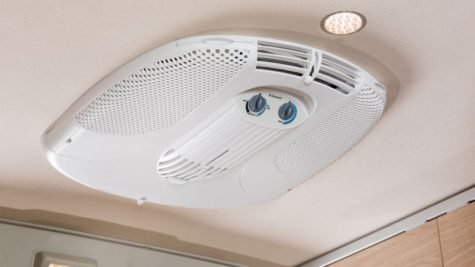
Heating, Ventilation, and Air Conditioning (HVAC)
In order to keep your Class B RV comfortable year-round, it’s essential to properly maintain the heating, ventilation, and air conditioning (HVAC) system. Here are some key maintenance tasks to keep in mind:
Maintaining the Furnace, Air Conditioning Unit, and Vents
Regular maintenance of your RV’s furnace, air conditioning unit, and vents is crucial for optimal performance. Make sure to:
- Clean the furnace regularly to remove any debris or dirt that could hinder its functionality.
- Inspect the air conditioning unit’s coils and fins to ensure they are clear of dust and debris, and clean as necessary.
- Check the vents for any blockages or obstructions that may restrict airflow, and clean them if needed.
Cleaning and Replacing Air Filters Regularly
Properly functioning air filters are essential for maintaining good indoor air quality and maximizing the efficiency of your HVAC system. Follow these steps:
- Regularly clean and inspect the air filters to remove any dirt or debris.
- If the filters are damaged or excessively dirty, replace them with new ones. It’s recommended to replace them at least once every three months.
Troubleshooting HVAC Issues & Knowing When to Seek Professional Help
While regular maintenance can prevent many HVAC problems, issues may still arise. Here’s what you can do:
- If you encounter any problems with your furnace, air conditioning unit, or vents, consult your RV owner’s manual for troubleshooting tips.
- If the issue persists or if you’re unsure about performing repairs, it’s best to seek professional help from an HVAC technician who specializes in RV systems.
By following these maintenance tips and staying vigilant about the health of your HVAC system, you can ensure a comfortable and enjoyable experience in your Class B RV, no matter the season.
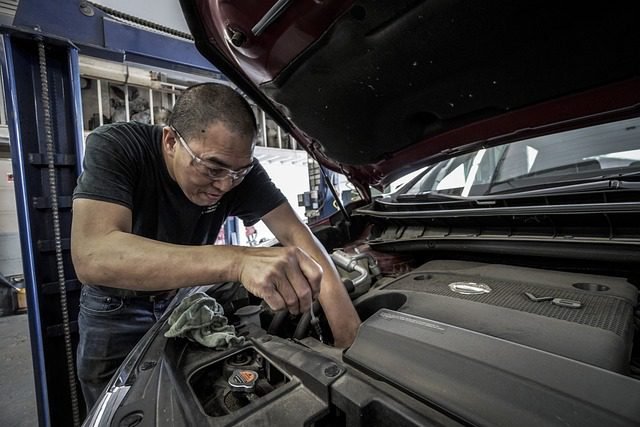
Image by Ryan Doka from Pixabay
DIY Maintenance vs. Professional Servicing
When it comes to maintaining your Class B RV, you have two options: DIY maintenance or professional servicing. Both have their advantages and disadvantages, and it’s important to consider various factors before making a decision.
Pros and Cons of DIY Maintenance Tasks
DIY maintenance tasks offer several benefits. Firstly, they are often more cost-effective compared to hiring a professional. By performing regular maintenance on your own, you can save money in the long run.
Additionally, DIY maintenance allows you to have full control over the process. You can ensure that the tasks are done to your satisfaction and according to your specific needs.
However, there are some downsides to consider as well. DIY maintenance requires knowledge, skills, and experience. If you’re not confident in your abilities, you may end up causing more harm than good. It’s important to thoroughly research and understand the task before attempting it.
Identifying Maintenance Tasks Best Left to Professionals
While many maintenance tasks can be done by RV owners themselves, there are certain aspects that are best left to professionals. These tasks include complicated engine repairs, electrical system diagnostics, and major plumbing repairs.
Professional RV technicians have the expertise and specialized tools to handle complex maintenance tasks. They can diagnose issues accurately and provide effective solutions, giving you peace of mind knowing that your RV is in capable hands.
Factors to Consider When Choosing Between DIY and Professional Servicing
When deciding between DIY and professional servicing, consider the following factors:
- Time and availability: DIY maintenance requires time and effort. If you have a busy schedule or limited availability, professional servicing may be a better option.
- Skills and experience: Evaluate your own skills and experience in RV maintenance. If you’re confident and knowledgeable, DIY may be suitable. Otherwise, it’s best to rely on professionals.
- Budget: Consider your budget for maintenance. DIY tasks may save money, but complex problems may require professional intervention.
- Warranty and insurance: Check your RV’s warranty and insurance policies. Some warranties may require professional servicing to remain valid.
Ultimately, the decision between DIY and professional servicing depends on your comfort level, availability, budget, and the specific maintenance task at hand.
Troubleshooting and FAQs

Image by Eluj from Pixabay
Common issues faced by Class B RV owners and their solutions
- 1. Problem: Water leaks in the RV Solution: Check for loose or damaged seals around windows, roof vents, and plumbing connections. Use appropriate sealant or repair products to fix any leaks.
- 2. Problem: Electrical issues Solution: Start by checking if the circuit breaker has tripped. If not, inspect the wiring for any damage or loose connections. Consider seeking professional help if the problem persists.
- 3. Problem: RV battery not charging Solution: Check the battery connections and terminals for corrosion. Clean or replace them if necessary. Also, ensure that the battery charger or converter is working properly.
- 4. Problem: Refrigerator not cooling Solution: Make sure the RV is level, as an unlevel surface can affect the fridge’s efficiency. Check if the fridge’s ventilation is blocked or if there are any obstructions in the cooling system. Clean the fridge’s coils and vents regularly.
- 5. Problem: Awning won’t retract Solution: Examine the awning for any obstructions or debris. Check the tension on the awning arms and make sure they are properly aligned. If needed, apply lubrication to the awning parts.
Step-by-step troubleshooting guide for addressing common problems
When faced with common issues in your Class B RV, follow these steps to troubleshoot and resolve them:
- Identify the problem by observing and understanding the symptoms.
- Consult the RV owner’s manual for any specific troubleshooting instructions related to the issue.
- Check the relevant systems or components for any visible damage, loose connections, or other issues.
- Perform basic maintenance tasks such as cleaning, lubricating, or tightening connections as needed.
- If the problem persists, conduct further research online or seek help from RV forums and communities.
- Consider contacting a professional RV technician if you are unable to resolve the problem on your own.
Frequently asked questions related to Class B RV maintenance
-
- Q: How often should I change the engine oil in my Class B RV?
A: It is generally recommended to change the engine oil every 3,000 to 5,000 miles or as advised by the vehicle manufacturer.
-
- Q: Can I use regular household cleaning products for my RV’s interior?
A: It is best to use RV-specific cleaning products to avoid damage to the surfaces and materials in your Class B RV.
-
- Q: How often should I flush and sanitize the RV’s water system?
A: It is recommended to flush and sanitize the water system at least once a year or whenever you notice an odor or taste issue.
-
- Q: Do I need to winterize my Class B RV?
A: Yes, winterizing your RV is crucial to prevent damage from freezing temperatures. Follow the manufacturer’s instructions or consult a professional for the correct winterization procedure.
-
- Q: Can I perform DIY repairs on my RV’s electrical system?
A: Unless you have experience and knowledge in working with electrical systems, it is safer to leave electrical repairs to a professional RV technician.
Conclusion
Regular RV maintenance is essential for keeping your rig in top condition and ensuring safe and enjoyable travels. By following the tips and advice in this post, you can learn how to perform basic maintenance tasks yourself, or you can hire a professional to do it for you. No matter which route you choose, regular maintenance will help you extend the life of your RV and avoid costly repairs down the road.
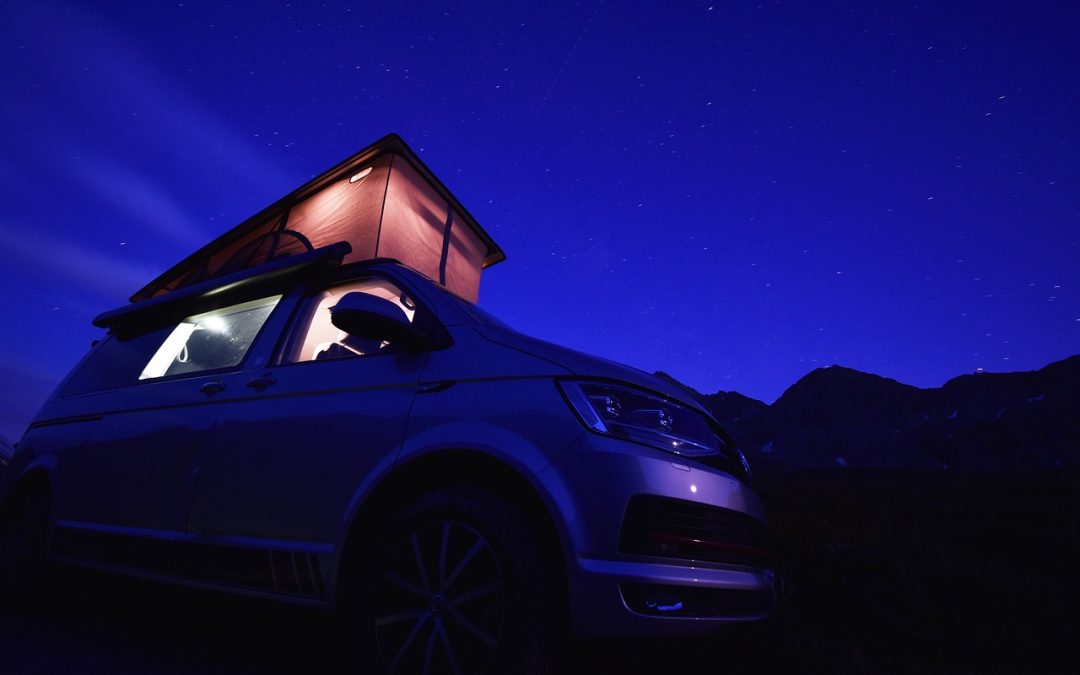
by Chuck Price | Jun 27, 2023 | Class B RV
The open road, the freedom to roam, the allure of new experiences around every bend—these are the siren calls of the RV nomad. But what does it really mean to adopt this lifestyle, particularly in a Class B RV?
In this article, we will explore the pros and cons of living as a Class B RV nomad. We will discuss the freedom and flexibility that this lifestyle offers, as well as the challenges and limitations. We will also provide some tips for those who are considering this lifestyle.
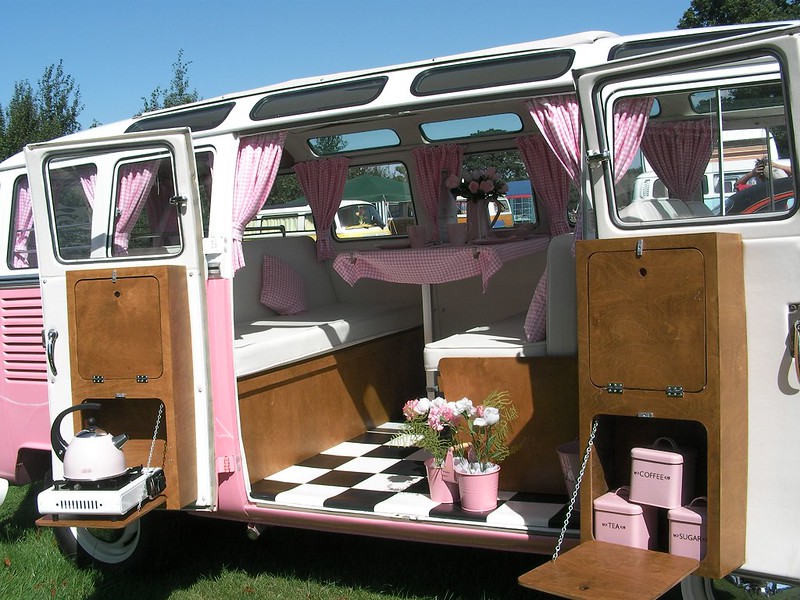
Image by Mark Fosh via flickr
Understanding the Nomadic Lifestyle
What is a Class B RV?
A Class B RV, often referred to as a “camper van,” is the smallest of the motorized RV classes. Despite their compact size, these vehicles are fully self-contained with a kitchen, bathroom, and sleeping area. They offer a balance between comfort and mobility, making them a popular choice among solo travelers and couples.
Here are some of the benefits of living in a Class B RV:
- Freedom and flexibility: You can go wherever you want, whenever you want. You’re not tied down to a lease or a mortgage, and you can easily change your plans if you need to.
- Experiencing new places: You’ll get to see new places and meet new people. You’ll have the opportunity to explore different cultures and learn about different ways of life.
- Affordability: Class B RVs are generally more affordable than larger RVs. This makes them a good option for people who are on a budget.
However, there are also some challenges to living in a Class B RV:
- Limited space: Class B RVs are small, so you’ll have to be organized and efficient with your space.
- Lack of privacy: If you’re traveling with other people, you may find that you have to share a small space.
- Maintenance: Class B RVs require regular maintenance, so you’ll need to be prepared to do some work on your own.
Overall, living in a Class B RV can be a great way to experience the freedom and flexibility of the open road. However, it’s important to be aware of the challenges before you make the decision to live this lifestyle.
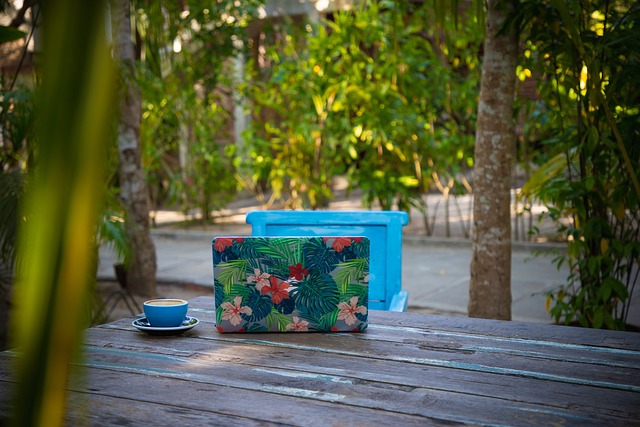
Image by Peggy und Marco Lachmann-Anke from Pixabay
The Nomadic Lifestyle: An Overview
The nomadic lifestyle is about embracing freedom and flexibility. It’s about breaking free from the conventional 9-to-5 routine and exploring the world at your own pace. For some, it’s a temporary adventure; for others, it’s a lifelong commitment.
There are many different ways to live a nomadic lifestyle. Some people choose to travel full-time in an RV or van. Others choose to work remotely from different locations around the world. And still others choose to live a more transient lifestyle, moving from place to place as they see fit.
No matter how you choose to live it, the nomadic lifestyle offers a unique set of challenges and rewards. On the one hand, you’ll have the freedom to experience new places and cultures, meet new people, and make new friends. On the other hand, you’ll also have to deal with the challenges of living in a small space, finding work, and maintaining a sense of community.
If you’re considering living a nomadic lifestyle, there are a few things you should keep in mind. First, make sure you have a plan. What are your goals? What are your resources? How will you make money? Second, be prepared for change. Things will not always go according to plan, so you need to be flexible and adaptable. Third, enjoy the journey! The nomadic lifestyle can be an amazing adventure, so make sure you savor every moment.
Here are some of the benefits of living a nomadic lifestyle:
- Freedom and flexibility: You can go wherever you want, whenever you want. You’re not tied down to a lease or a mortgage, and you can easily change your plans if you need to.
- Experiencing new places: You’ll get to see new places and meet new people. You’ll have the opportunity to explore different cultures and learn about different ways of life.
- Affordability: Living a nomadic lifestyle can be more affordable than living a traditional lifestyle. You can save money on rent, utilities, and transportation.
- Personal growth: Living a nomadic lifestyle can help you to grow as a person. You’ll learn to be more independent and resourceful. You’ll also learn to appreciate the simple things in life.
Here are some of the challenges of living a nomadic lifestyle:
- Limited space: If you’re living in a small space, you’ll have to be organized and efficient with your belongings.
- Lack of privacy: If you’re traveling with other people, you may find that you have to share a small space.
- Homesickness: It can be difficult to be away from your friends and family for extended periods of time.
- Loneliness: If you’re traveling alone, you may find that you feel lonely at times.
- Maintenance: RVs and vans require regular maintenance, so you’ll need to be prepared to do some work on your own.
Overall, the nomadic lifestyle can be a great way to experience the freedom and flexibility of the open road. However, it’s important to be aware of the challenges before you make the decision to live this lifestyle.
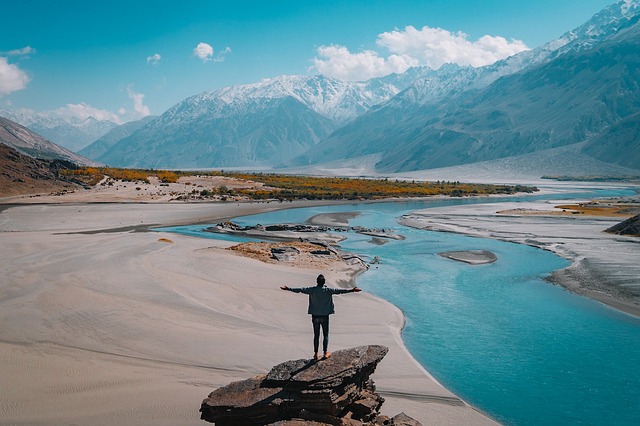
Image by Sofia Cristina Córdova Valladares from Pixabay
Pros of Living as a Class B RV Nomad
Freedom and Flexibility
One of the biggest advantages of being a Class B RV nomad is the unparalleled freedom and flexibility. You can travel wherever you want, whenever you want. You’re not tied down to a specific location or schedule.
If you don’t like your current surroundings, you can simply start the engine and drive to a new destination. This can be a great way to escape the hustle and bustle of everyday life and explore new places and cultures.
Experiencing New Places
Another great advantage of living as a Class B RV nomad is the opportunity to experience new places. You’ll get to see some of the most beautiful and interesting places in the world, from national parks to small towns to big cities. You’ll also have the chance to meet new people and learn about different cultures.
Affordability
Living as a Class B RV nomad can also be more affordable than living a traditional lifestyle. You can save money on rent, utilities, and transportation. You can also cook your own meals, which can save you even more money.
Personal Growth
Living as a Class B RV nomad can also be a great way to grow as a person. You’ll learn to be more independent and resourceful. You’ll also learn to appreciate the simple things in life.
Overall, there are many great advantages to living as a Class B RV nomad. If you’re looking for a lifestyle that offers freedom, flexibility, and adventure, then this may be the perfect option for you.
Minimalistic Living
Living in a Class B RV encourages a minimalist lifestyle. With limited space, you learn to prioritize needs over wants, which can lead to a more mindful and sustainable way of living.
Here are some of the benefits of minimalist living:
- Less clutter: When you have less stuff, your space feels more open and airy. You’re also less likely to feel overwhelmed or stressed by clutter.
- More focus: When you have less stuff, you’re forced to focus on the things that are truly important to you. This can lead to a more fulfilling and meaningful life.
- More sustainability: When you have less stuff, you consume fewer resources. This is good for the environment and for your wallet.
- More freedom: When you have less stuff, you’re more mobile. You can easily pack up and move to a new location, which gives you a sense of freedom and adventure.
Of course, there are also some challenges to minimalist living:
- It can be difficult to let go of things. When you’ve been attached to something for a long time, it can be hard to let it go, even if you don’t need it anymore.
- It can be expensive to get rid of things. If you have a lot of stuff, it can be expensive to get rid of it all. You may have to pay for junk removal or donation fees.
- It can be lonely. If you’re used to having a lot of stuff, you may feel lonely when you first start living a minimalist lifestyle. You may have to learn to find new ways to connect with people and make friends.
Overall, there are both benefits and challenges to minimalist living. If you’re considering this lifestyle, it’s important to weigh the pros and cons carefully.
Connection with Nature
Being an RV nomad often means spending a lot of time in nature. Whether you’re parked by a serene lake or nestled in a forest , you get to enjoy the beauty of the natural world right outside your door.
Here are some of the benefits of connecting with nature:
- Reduced stress: Spending time in nature has been shown to reduce stress levels and improve mental health.
- Improved mood: Being surrounded by nature can boost your mood and make you feel more positive.
- Increased creativity: Nature can inspire creativity and help you to think outside the box.
- Better sleep: Studies have shown that people who sleep in nature get better sleep than those who sleep in urban areas.
- Enhanced immune system: Exposure to nature can help to boost your immune system and protect you from disease.
Of course, there are also some challenges to connecting with nature:
- Weather: You may have to deal with extreme weather conditions, such as rain, snow, or heat.
- Wildlife: You may encounter wildlife, such as bears, snakes, or insects.
- Loneliness: If you’re traveling alone, you may feel lonely at times.
Overall, there are both benefits and challenges to connecting with nature. If you’re considering this lifestyle, it’s important to weigh the pros and cons carefully.
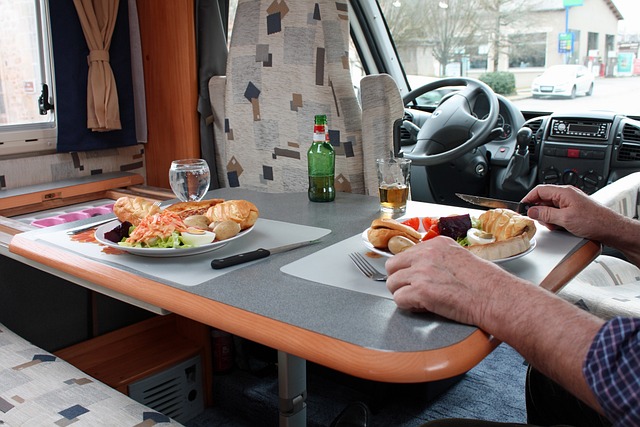
Image by inkflo from Pixabay
Cons of Living as a Class B RV Nomad
Limited Space
One of the main drawbacks of a Class B RV is the limited space. While it’s enough for basic living, there’s not much room for extras. This can be challenging for those who enjoy having a lot of personal belongings or for those who need a separate workspace.
Here are some tips for dealing with limited space in a Class B RV:
- Be selective about your belongings. Only bring the things that you absolutely need.
- Get creative with your storage solutions. Use vertical space, under-bed storage, and even the walls to store your belongings.
- Declutter regularly. Get rid of anything that you don’t use or need.
- Be prepared to downsize. If you’re not willing to give up some of your belongings, then a Class B RV may not be the right choice for you.
Overall, limited space is one of the biggest challenges of living in a Class B RV. However, it’s not impossible to make it work. With a little planning and creativity, you can learn to live comfortably in a small space.
Maintenance and Repair
Like any vehicle, a Class B RV requires regular maintenance and occasional repairs. These can be costly and inconvenient, especially when you’re on the road.
Here are some tips for minimizing maintenance and repair costs:
- Get regular oil changes and tune-ups. This will help to keep your RV running smoothly and prevent major problems down the road.
- Inspect your RV regularly for signs of wear and tear. This will help you to catch small problems before they become big ones.
- Do your own maintenance and repairs whenever possible. This will save you money on labor costs.
- Carry a tool kit and basic spare parts with you. This will help you to make minor repairs on the road.
Even if you follow these tips, there will still be times when you need to take your RV to a mechanic. Be sure to get estimates from several mechanics before you have any work done. This will help you to find the best price for the services you need.
Overall, maintenance and repair costs are one of the biggest challenges of owning a Class B RV. However, by following these tips, you can minimize these costs and keep your RV running smoothly for years to come.
Lack of Stability
While the nomadic lifestyle offers freedom, it also lacks stability. Things like healthcare, mail service, and social connections can be more challenging to manage.
Here are some of the challenges of living a nomadic lifestyle without stability:
- Healthcare: It can be difficult to find and maintain health insurance when you’re constantly on the move. You may also have to travel long distances to see a doctor or specialist.
- Mail service: If you’re not living in a permanent address, it can be difficult to receive mail. You may have to use a mail forwarding service or a PO Box.
- Social connections: It can be difficult to maintain social connections when you’re constantly moving. You may have to make new friends every time you move to a new place.
There are a few things you can do to mitigate the challenges of living a nomadic lifestyle without stability:
- Plan ahead. Before you hit the road, make sure you have a plan for healthcare, mail service, and social connections.
- Be flexible. Things don’t always go according to plan, so be prepared to be flexible.
- Be resourceful. There are a lot of resources available to help nomads, so be sure to take advantage of them.
Overall, the lack of stability is one of the biggest challenges of living a nomadic lifestyle. However, it’s not impossible to overcome these challenges. With a little planning and flexibility, you can learn to live a stable and fulfilling life on the road.
Conclusion
Living as a Class B RV nomad is a unique experience filled with both rewards and challenges. It offers an unparalleled sense of freedom and a deep connection with nature, but it also requires a willingness to live minimally and handle the occasional bumps on the road. Ultimately, whether this lifestyle is right for you depends on your personal preferences and circumstances.
Here are some things to consider when deciding if living as a Class B RV nomad is right for you:
- Your personality: Are you someone who enjoys being on the go and exploring new places? Or do you prefer a more stable and predictable lifestyle?
- Your financial situation: Can you afford the upfront cost of an RV and the ongoing costs of maintenance, fuel, and campground fees?
- Your lifestyle: Do you have a job that you can do remotely? Or will you need to find a new way to make a living?
- Your family: If you have children or pets, are you prepared to homeschool them or find a new place for them to go to school?
If you’re considering living as a Class B RV nomad, I encourage you to do your research and talk to other people who have lived this lifestyle. There are many resources available to help you make the decision that’s right for you.
FAQs
Q: What are the pros and cons of living in a Class B RV?
Pros:
- Freedom: Living in a Class B RV gives you the freedom to travel wherever you want, whenever you want.
- Connection with nature: You’ll be able to spend more time in nature and explore new places.
- Minimalism: Living in a small space forces you to be more minimalist and only bring the things that you really need.
- Adventure: Living in a Class B RV is an adventure in itself. You’ll never know what you’ll experience next.
Cons:
- Limited space: Class B RVs are small, so you’ll have to be creative with your storage space.
- Maintenance: Class B RVs require regular maintenance, so you’ll need to be prepared to do some work.
- Cost: Living in a Class B RV can be expensive, especially if you’re traveling to high-cost areas.
- Lack of stability: You may not have a permanent address, so it can be difficult to maintain social connections and keep track of your mail.
Q: What are some of the things to consider when choosing a Class B RV?
- The size of your vehicle: Class B RVs come in a variety of sizes, so you’ll need to choose one that’s big enough for your needs but not too big that it’s difficult to drive or park.
- The amenities you need: Consider what amenities are important to you, such as a kitchen, bathroom, and sleeping area.
- Your budget: Class B RVs can range in price from a few thousand dollars to over $100,000, so it’s important to set a budget before you start shopping.
- Your lifestyle: If you have children or pets, you’ll need to choose an RV that’s big enough to accommodate them.
Q: What are some of the best places to live in a Class B RV?
A: The beauty of living in a Class B RV is that you can choose your surroundings. Depending on your preferences, here are some of the best places to park your RV:
- National Parks: The United States is home to 63 stunning national parks, each offering unique landscapes and outdoor activities. From the geysers of Yellowstone to the majestic mountains of Yosemite, national parks provide a wonderful backdrop for RV living.
- Small Towns: Small towns often offer a warm welcome to RVers. They provide a sense of community and are generally more affordable than larger cities. Plus, you’ll often find unique local attractions and experiences.
- Beaches: For those who love the sound of waves and the feel of sand between their toes, beachside living is ideal. There are numerous RV parks located along both the east and west coasts of the U.S., such as Myrtle Beach in South Carolina or Huntington Beach in California.
- Wine Country: Regions known for their vineyards, like Napa Valley in California or the Finger Lakes in New York, often have RV-friendly accommodations. You can spend your days touring wineries and your evenings enjoying a glass of local wine at your campsite.
- Mountains: If you’re a fan of hiking, skiing, or just love the mountain air, consider parking your RV in mountainous areas. The Rocky Mountains, the Smoky Mountains, and the Sierra Nevada are just a few examples of mountain ranges with RV-friendly accommodations.
Remember, wherever you choose to park your RV, always ensure you’re following local laws and regulations, and respect the environment around you.
Q: How do I find jobs that I can do remotely?
A: In today’s digital age, finding remote work has become increasingly accessible. There are numerous websites dedicated to listing remote jobs across various industries. Here are some of the top websites where you can find remote work:
- Remote.co: This platform offers a wide range of remote jobs from companies around the world. They also provide useful resources and insights for remote workers and digital nomads.
- WeWorkRemotely: As one of the largest remote work communities in the world, WeWorkRemotely offers a vast selection of jobs that span across many fields.
- FlexJobs: FlexJobs offers a curated list of remote jobs. While it requires a subscription, the quality of jobs and the amount of scam-free listings can make it worth the investment.
- Working Nomads: This site curates lists of the most interesting remote job offers in many professional career areas.
- RemoteOK: RemoteOK offers a variety of remote jobs for digital nomads, with the ability to filter by job type, experience level, and more.
Other notable mentions include Virtual Vocations, Dribbble, Upwork, and Freelancer. These platforms cater to a wide range of professions and skill sets. Remember, when applying for remote jobs, it’s important to demonstrate your ability to work independently and communicate effectively. You can also search for remote jobs on job boards like Indeed and Monster.
Q: How do I stay connected with friends and family while I’m on the road?
A: Maintaining connections with loved ones while on the road is crucial, especially for those living a nomadic lifestyle. Thankfully, technology has made it easier than ever to stay in touch, no matter where you are. Here are some strategies you can use:
- Using Social Media: Platforms like Facebook, Instagram, and Twitter allow you to share updates about your travels and stay updated on what’s happening in the lives of your friends and family.
- Calling and Texting: Traditional phone calls and text messages are still a reliable way to communicate. Just make sure you have a mobile plan that supports long-distance communication.
- Video Chatting: Apps like Skype, Zoom, WhatsApp, and FaceTime (for Apple users) offer video calling features that can make conversations more personal.
- Visiting in Person: If your travel route and schedule allow, plan visits with friends and family along the way. This can be a great way to break up long stretches of travel and spend quality time with loved ones.
- Email: Don’t underestimate the power of a well-written email. It’s a great way to share more detailed updates about your travels and feelings.
- Blogging or Vlogging: Starting a blog or vlog about your travels can be a fun way to share your experiences. Platforms like YouTube for vlogging and WordPress for blogging are popular choices.
Remember, while these tools can help maintain connections, they also require internet access. So, make sure to plan for reliable internet connectivity during your travels.
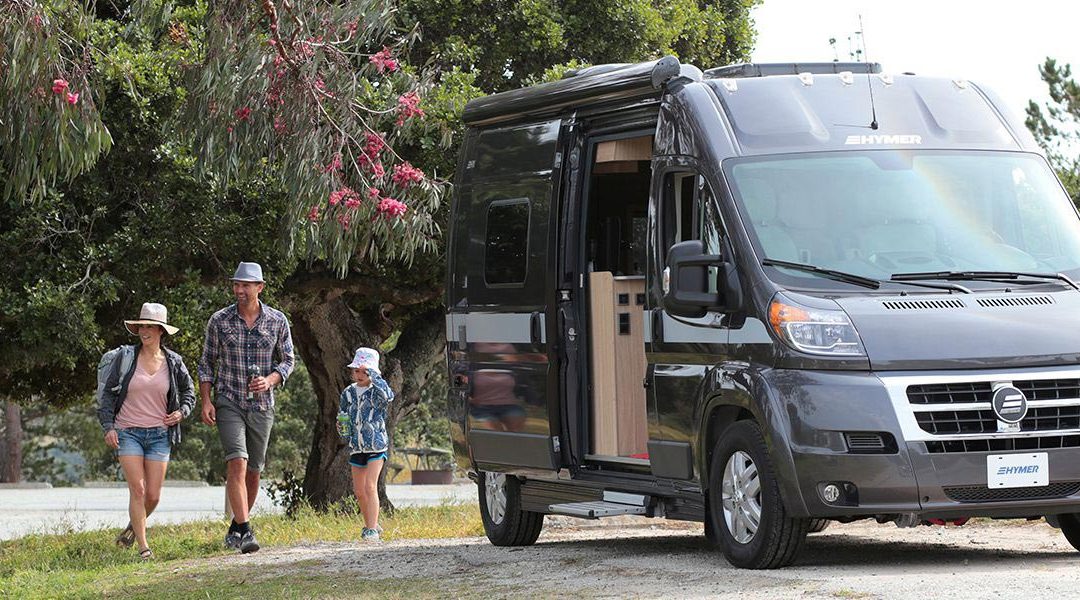
by Chuck Price | Jun 10, 2023 | Class B RV
Updated November 25, 2024
Did you know that Class B RV ownership grew by over 15% in 2023, driven by travelers seeking compact convenience and adventure? These “camper vans” are gaining popularity for their ability to combine the comforts of home with the freedom of the open road.However, while the allure of Class B RVs is undeniable, the hidden costs of ownership often surprise even seasoned RVers. Maintenance, unexpected repairs, and operational expenses can add up quickly, making budgeting a critical aspect of RV ownership.Consider MWeiner from the iRV2 forums, who reported spending over $10,000 on unexpected repairs in a single year. These expenses included generator replacement, refrigerator repair, and other maintenance tasks that caught them off guard. Understanding these hidden costs is essential for anyone considering a Class B RV.This guide explores all aspects of the hidden costs of Class B RV ownership, equipping you with the insights and strategies needed to budget effectively and enjoy a stress-free RV lifestyle.

What Are Class B RVs?
Class B RVs, often referred to as camper vans, are compact motorhomes built on a van chassis. Despite their small size, they are equipped with essential amenities, including kitchens, bathrooms, and sleeping areas. These features make them an excellent choice for solo travelers, couples, or small families seeking freedom and flexibility on the road.
One of the key advantages of Class B RVs is their maneuverability. Their smaller size allows for easier navigation on narrow roads and in urban areas, making them ideal for both city explorations and remote adventures. Learn more about Class B RV features from the RV Industry Association.
Compared to their larger counterparts, Class A and Class C motorhomes, Class B RVs are typically more fuel-efficient. However, smaller doesn’t always mean cheaper. While Class A motorhomes are known for their luxury and Class C motorhomes strike a balance between size and cost, Class B RVs often carry premium price tags due to their compact and versatile designs. For a comprehensive comparison of RV classes, check out Consumer Reports.
In short, Class B RVs offer an appealing blend of comfort, efficiency, and versatility, but understanding their maintenance needs and associated costs is essential for long-term satisfaction.
The True Cost of Class B RV Ownership
Owning a Class B RV is about more than just the initial purchase price. Beyond the sticker cost, there are recurring expenses for maintenance, repairs, insurance, fuel, and storage. For prospective owners, it’s essential to anticipate these ongoing costs to avoid financial surprises.
According to the RV Dealers Association, annual maintenance for a Class B RV typically ranges from $1,000 to $3,000, depending on usage, condition, and location. Operational costs, such as insurance and storage, can vary widely based on factors like your region and the size of your RV.
Another significant cost to consider is depreciation. The Bureau of Transportation Statistics reports that vehicles, including RVs, lose a substantial portion of their value within the first few years. This depreciation can affect resale value and long-term cost calculations.
To manage these costs effectively, experts recommend setting aside 10% of your RV’s purchase price annually for maintenance and unexpected repairs. For example, if your RV costs $100,000, budgeting $10,000 per year can help ensure you’re financially prepared for any surprises.
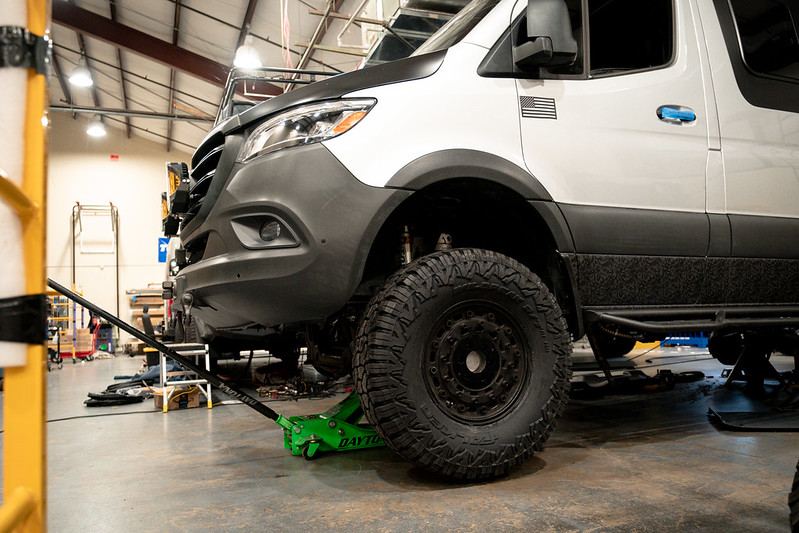
Routine Maintenance: A Breakdown of Costs
Keeping your Class B RV in excellent condition starts with routine maintenance. These tasks are essential to avoid breakdowns and extend the lifespan of your vehicle. Here’s a breakdown of key maintenance activities and their estimated costs:
- Oil Changes: Required every 3,000–5,000 miles; costs $50–$100 per service.
- Tire Rotations: Recommended every 6,000–10,000 miles; costs $20–$50 per rotation.
- Brake Inspections: Performed every 12,000–15,000 miles; costs $30–$50. Replacements cost significantly more.
- Battery Maintenance: Annual checks ensure reliability; replacements cost $100–$300.
- HVAC, Plumbing, and Electrical Checks: Annual system inspections typically add $200–$500 to your maintenance budget.
For specific guidance tailored to your RV model, consult your owner’s manual or the ASE directory for certified professionals.
Factors Influencing Maintenance Costs
Beyond routine tasks, several factors significantly impact the overall cost of maintaining a Class B RV. Here are the key variables to consider:
- Age and Condition: Older RVs generally require more repairs and part replacements compared to newer models. Regular inspections can help catch issues early.
- Mileage: Higher mileage leads to increased wear and tear, particularly on tires, brakes, and suspension components.
- Frequency of Use: Full-time RV living puts more strain on systems than occasional vacations. Over time, this increases maintenance costs.
- Type of Usage: Activities like boondocking, which relies on onboard systems like plumbing and electrical, often result in faster wear and higher maintenance needs.
- Climate and Environment: RVs exposed to harsh weather conditions (e.g., extreme heat, cold, or moisture) experience accelerated deterioration. Conversely, RVs stored in garages or under covers benefit from reduced exposure.
Understanding these factors helps you anticipate potential maintenance costs based on how and where you use your RV. For additional tips, visit the RV Dealers Association.
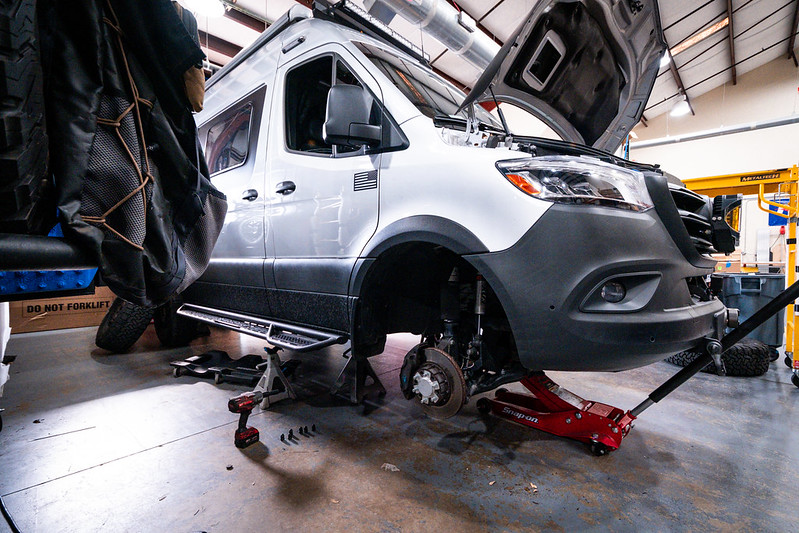
Beyond Routine Maintenance
While routine maintenance addresses the basics, your Class B RV also contains specialized systems that require attention. Neglecting these can lead to costly repairs down the line. Below are some key systems and their maintenance needs:
- Plumbing: Regularly check for leaks, replace water filters, and drain the gray and black water tanks. Professional inspections may cost $100–$200 annually.
- Electrical: Inspect wiring connections for wear or damage, replace blown fuses, and ensure all systems are operating efficiently. Repairs or upgrades can cost $200–$500 depending on the complexity.
- Propane: Test propane systems for leaks and safety annually. Tanks should be inspected by a certified technician every 10 years, with costs ranging from $50–$150.
- HVAC: To keep your RV comfortable in all seasons, clean air filters, inspect ductwork, and schedule annual servicing with a qualified technician. HVAC maintenance can cost $200–$300 per year.
Ensuring these systems are in good condition not only prevents costly breakdowns but also enhances your overall travel experience. Consult the ASE directory for certified RV technicians who can assist with these tasks.
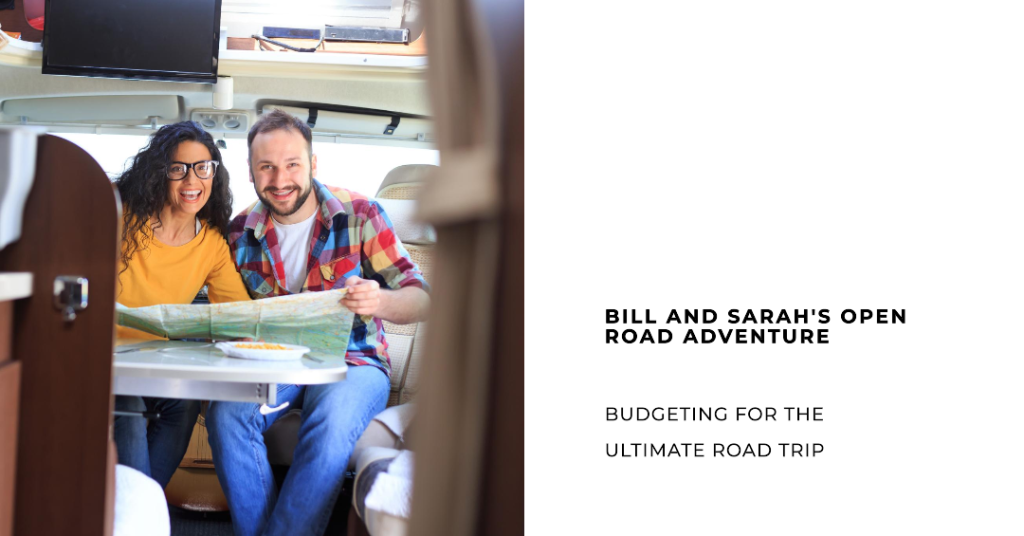
Case Study: Budgeting for Adventures
Meet Sarah and Bill, a couple nearing retirement with plans to explore North America’s breathtaking national parks in a Class B RV. Alongside their one-year-old dog, they’ve mapped out an ambitious travel schedule and created a detailed budget to prepare for the financial demands of RV ownership.
Here’s a breakdown of their projected annual expenses:
- Regular Maintenance: Oil changes, tire rotations, and brake inspections add up to $2,500–$3,000 per year.
- Specific System Maintenance: Plumbing, electrical, HVAC, and propane systems require an additional $100–$300 annually.
- Insurance and Storage: Coverage and storage fees vary by location but cost $1,000–$2,000 per year.
- Unexpected Repairs: To cover unforeseen expenses like generator or transmission issues, they’ve set aside a buffer of $10,000, equivalent to 10% of their RV’s purchase price.
By planning ahead and sticking to their budget, Sarah and Michael can embark on their RV adventures with confidence, knowing they’re financially prepared for whatever challenges may arise.
Tips to Minimize Costs and Maximize Longevity
Keeping your Class B RV in excellent condition doesn’t have to be expensive. With a proactive approach, you can minimize costs while extending the life of your RV. Here are some practical tips:
- Follow a Regular Maintenance Schedule: Sticking to routine maintenance prevents small issues from escalating into costly repairs. Create a checklist based on your RV’s manual.
- Invest in Seasonal Care: Proper winterization protects against freezing damage, while moisture management during humid months prevents mold and mildew. The RV Dealers Association offers detailed seasonal care guides.
- Handle Basic DIY Repairs: Tasks like replacing air filters, checking tire pressure, and cleaning interior systems can save hundreds of dollars annually. For advanced repairs, rely on certified professionals from the ASE directory.
- Shop Around for Insurance and Storage: Compare quotes from multiple providers to secure competitive rates. Reevaluate policies annually to ensure they meet your needs.
- Use High-Quality Parts: Opt for OEM (Original Equipment Manufacturer) parts for repairs. While pricier upfront, they offer better durability and compatibility than generic alternatives.
By following these tips, you can enjoy stress-free travels and reduce the financial burden of RV ownership. A little effort goes a long way in preserving the value and reliability of your Class B RV.
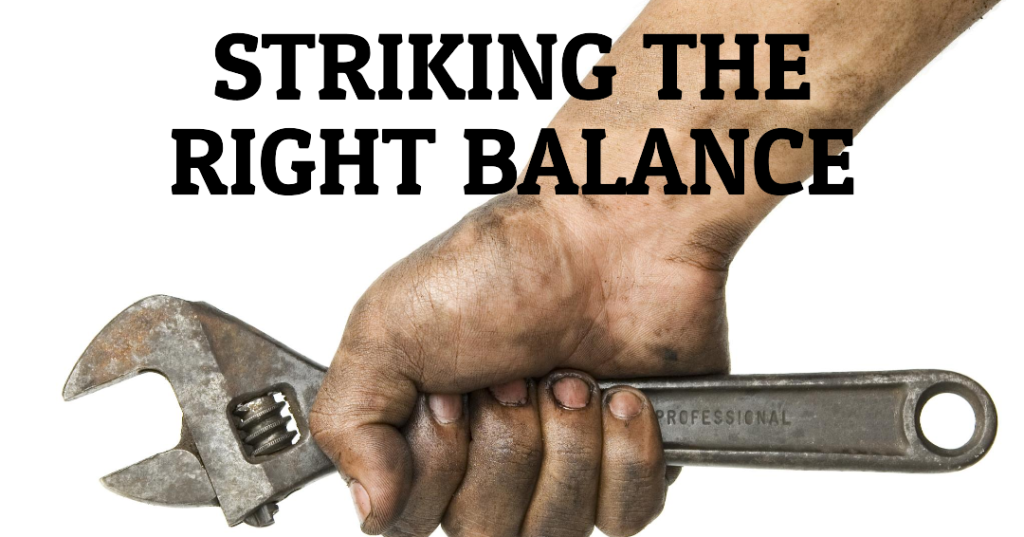
Comparing Costs: Class B vs. Class A and C Motorhomes
When deciding which type of RV to purchase, understanding the differences in costs between Class B, Class A, and Class C motorhomes is essential. Each type offers unique advantages and trade-offs, depending on your travel needs and budget.
Class A Motorhomes: These large, bus-like vehicles are the epitome of luxury, with spacious interiors and high-end features. Starting prices exceed $100,000, and premium models can cost upwards of $500,000. Their size and complexity result in higher maintenance costs and lower fuel efficiency. Learn more about Class A motorhomes from the RV Industry Association.
Class C Motorhomes: Built on a truck or van chassis, Class C motorhomes offer a balance between size and affordability. They typically start at around $81,000 and are easier to maintain compared to Class A models. However, they lack the maneuverability of Class B RVs, making them less suitable for urban travel. For an in-depth comparison, refer to Consumer Reports.
Class B Motorhomes: Despite their smaller size, Class B RVs often come with higher upfront costs due to their compact and versatile designs. Starting prices range from $81,000 to $151,000. Their appeal lies in their fuel efficiency, ease of driving, and suitability for both city and remote adventures. However, as highlighted in the iRV2 community, maintenance for compact systems like refrigerators and plumbing can still be expensive.
Each motorhome class caters to different needs, and the best choice depends on factors like group size, travel frequency, and willingness to manage maintenance demands. Weighing the operational and maintenance costs alongside purchase prices is critical to making an informed decision.
FAQ: Common Questions About Class B RV Maintenance
Whether you’re a prospective owner or a seasoned traveler, understanding the maintenance requirements of a Class B RV is vital. Below are answers to some frequently asked questions:
- How much does it cost to maintain a Class B RV annually?
Maintenance costs typically range from $1,000 to $3,000 annually, depending on usage and condition. For more details, refer to the RV Industry Association.
- What are the most common repairs for Class B RVs?
Common repairs include generator replacements, plumbing fixes, and HVAC servicing. These repairs can range from $500 to $5,000, as noted by Consumer Reports.
- Can I perform maintenance tasks myself, or should I hire a professional?
While minor tasks like replacing air filters or checking tire pressure can be done at home, more complex issues should be handled by a certified technician. The ASE directory offers a list of qualified professionals.
- How often should I perform routine maintenance?
Oil changes should be done every 3,000–5,000 miles, tire rotations every 6,000–10,000 miles, and brake inspections every 12,000–15,000 miles. Follow your RV’s owner’s manual for detailed schedules.
- What should I budget for unexpected repairs?
Experts recommend setting aside 10% of your RV’s purchase price annually as a buffer for unexpected expenses. For example, if your RV costs $100,000, allocate $10,000 for unforeseen repairs. Learn more about budgeting from the Consumer Financial Protection Bureau.
Staying informed about these common concerns ensures you’re better prepared for the financial responsibilities of RV ownership.
Conclusion
Owning a Class B RV offers unmatched freedom and versatility, but understanding and planning for the hidden costs of ownership is crucial for a stress-free experience. From routine maintenance to unexpected repairs, operational expenses to system-specific care, budgeting proactively ensures you’re financially prepared for life on the road.
By following expert advice, like setting aside 10% of your RV’s purchase price annually, investing in high-quality parts, and adopting seasonal care practices, you can extend the life of your RV while minimizing expenses. Whether you’re a first-time buyer or a seasoned adventurer, these strategies pave the way for more enjoyable and worry-free travels.
Ready to learn more? Subscribe to our newsletter for RV maintenance tips, budget-friendly travel ideas, and the latest industry updates. Have questions or experiences to share? Join the conversation on iRV2 forums and connect with other Class B RV enthusiasts!
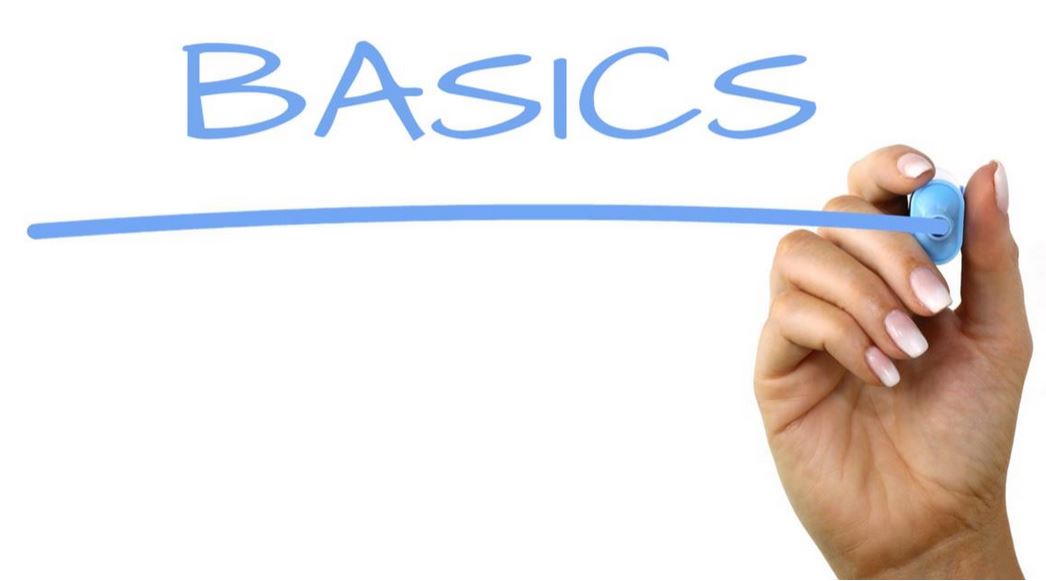
by Chuck Price | Jun 6, 2023 | Class B RV
Brief Overview of Class B RVs
When it comes to RVing, Class B RVs have gained a reputation for their convenient and comfortable compact design. These vehicles, often called camper vans, provide the mobility of a standard-sized van combined with the functionality of a fully-equipped motorhome.
Different Types of Class B RVs
Class B RVs come in various models, each with unique characteristics. Some popular types include the standard van camper, the high-top van, and the pop-top van, which includes a retractable roof section to increase standing space when parked. The variation in models allows potential owners to choose an RV that best suits their specific travel needs and comfort preferences.
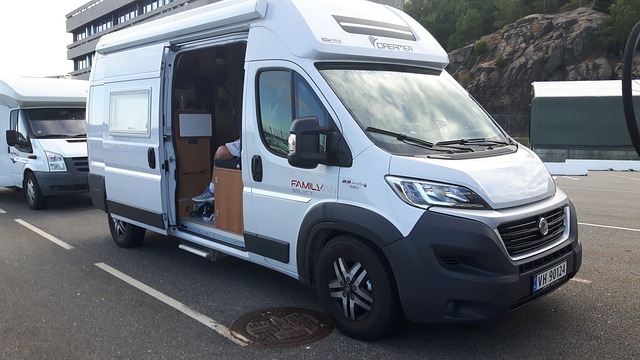
Image by Dan from Pixabay
Top 10 Basics Every Class B RV Owner Should Know
1. Understand Your Vehicle’s Capabilities
Every Class B RV owner should have a clear understanding of their vehicle’s unique capabilities. Vehicle Weight, Towing Capacity, and Fuel Efficiency play vital roles in how the vehicle performs on the road, how much it can haul, and how far it can travel on a single tank of fuel.
Next is understanding the RV’s various Operating Systems. This includes knowing how to manage the RV’s water system, maneuver the electrical wiring, and handle waste disposal, which contributes significantly to a smooth RVing experience.
2. Get Familiar with the Rules of the Road
As an RV driver, it is important to acknowledge that you will be subject to different rules and Special Regulations for RVs. This can include unique parking restrictions, speed limits, and even certain road access restrictions based on the size and weight of your RV.
3. Plan Your Route Carefully
When setting out on an adventure in your Class B RV, the journey is as important as the destination. Careful planning of your route is essential. Considering your RV’s Size and Weight will help you avoid roads unsuitable for your vehicle, while also Finding Parking and Camping Spots along the way ensures you have safe and legal places to stop and rest.
4. Pack Light
The way you pack can drastically affect the way your RV performs. The Impact of Weight on Performance and Fuel Efficiency is significant – the lighter the load, the better the fuel economy and overall handling. As Class B RVs have limited storage, prioritizing essentials will make your journey smoother.
5. Be Prepared for Emergencies
Regardless of how carefully you plan, unexpected issues can arise. Being prepared for emergencies by having Essential Emergency Supplies can make all the difference. This includes a well-stocked first-aid kit, extra food, water, and essential tools.
6. Stay Connected
Even while enjoying the solitude of the open road, it’s vital to Stay Connected. This can mean having reliable access to internet services, being able to communicate with others, and keeping updated with weather forecasts.
7. Respect the Environment
Part of the allure of RVing is being able to immerse yourself in nature. Ensuring you follow Environmentally Friendly RV Practices helps preserve these spaces for future visitors. Always dispose of waste properly, stick to designated roads and trails, and aim to reduce your overall environmental footprint.
8. Be a Good Neighbor
Campgrounds often bring people from different walks of life together. Therefore, it’s crucial to Respect Fellow Campers and Campground Rules. Maintain reasonable noise levels, respect others’ space, and follow all campground regulations.
9. Regular Maintenance and Care
To keep your Class B RV running smoothly and to avoid unexpected breakdowns, Regular Maintenance and Care is paramount. This can include periodic oil changes, checking tire pressure, inspecting for leaks, and ensuring your battery is in good condition. It’s also important to clean and check the various systems in your RV regularly, such as the water, electrical, and waste systems, to ensure they are functioning properly.
10. Have Fun!
Despite the responsibilities and challenges that come with it, RVing is fundamentally about enjoying the freedom of the road. Embrace the Joy of the RV Lifestyle, explore new places, meet new people, and create unforgettable memories.
The Different Types of RV Parks
Just as there are various types of Class B RVs, there are also numerous types of RV parks. These range from luxury RV resorts offering amenities like swimming pools and gyms, to basic campgrounds with minimal facilities. Choosing the right type depends on your personal needs, preferences, and budget.
Conclusion
Owning a Class B RV is both a responsibility and a joy. By understanding and adhering to these ten basics, you can ensure a smooth, memorable, and rewarding RVing experience. Always remember: safety, respect, and preparedness pave the way for great adventures.
Frequently Asked Questions
1. What kind of maintenance does a Class B RV require?
Regular maintenance for a Class B RV involves both mechanical and interior care. Mechanically, you should regularly check and maintain engine fluids, tire pressure, and brake systems. It’s also important to check for any leaks in the roof and windows and to keep the undercarriage clean, especially if you’ve driven on salted roads. Interior care involves cleaning and checking the functionality of appliances, water systems, and waste systems. It’s recommended to have a professional RV service to inspect your RV annually.
2. How do I prepare my Class B RV for a long trip?
To prepare your Class B RV for a long trip, start by checking all mechanical aspects of your RV, including fluid levels, tire pressure, brakes, and lights. You should also ensure your appliances, air conditioning, water, and waste systems are working correctly. Plan your route carefully, taking into consideration the size and capabilities of your RV. Pack essential items, but remember to keep the weight limit in mind. Lastly, ensure you have an emergency kit, including first-aid supplies, spare tires, extra food and water, and necessary tools.
3. What’s the average gas mileage for a Class B RV?
The gas mileage for Class B RVs can vary greatly depending on the specific model, weight of the RV, speed, and driving conditions. However, on average, Class B RVs tend to get around 18-25 miles per gallon (mpg). Keep in mind that towing a vehicle, driving at high speeds, or going uphill can significantly decrease fuel efficiency.
4. Can I park my Class B RV anywhere?
No, you cannot park your Class B RV just anywhere. Different cities, states, and countries have specific laws and regulations regarding where RVs can be parked. Some residential areas, city streets, and even some commercial areas like shopping centers may have restrictions against RV parking. It’s essential to research and abide by local laws and regulations. When in doubt, campgrounds and RV parks are typically safe and legal options for parking your RV.
5. Do all Class B RVs come with a bathroom?
Most Class B RVs come equipped with a bathroom. This usually includes a toilet and a shower, although in some models, the toilet and shower may be combined into a single “wet bath” due to space limitations. However, there are some models, usually older or more basic ones, that may not have a bathroom, so it’s always best to check the specific features of an RV before purchasing or renting.
Featured Image Credit: by Nick Youngson CC BY-SA 3.0 Alpha Stock Images:












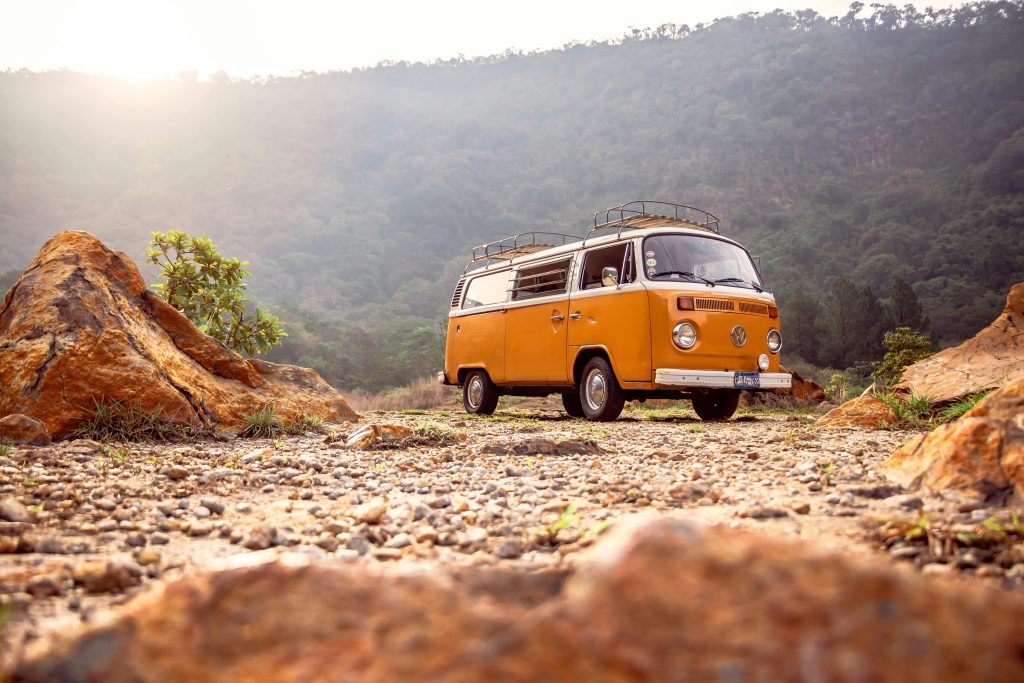










 Safety and Emergency Preparedness
Safety and Emergency Preparedness


 Image by
Image by 














